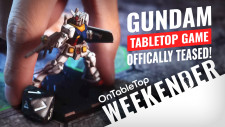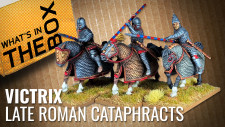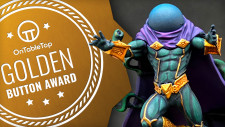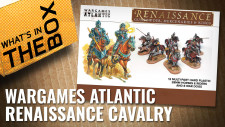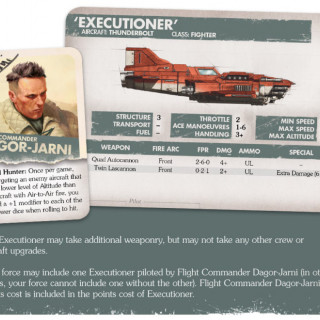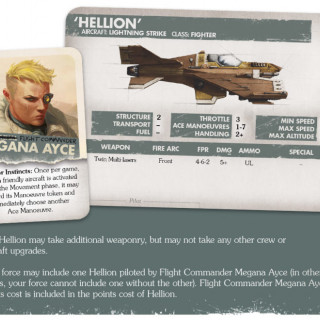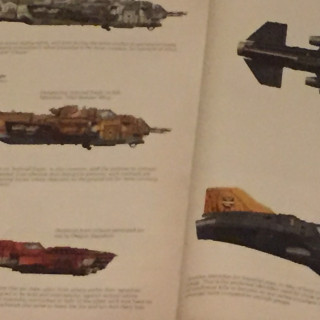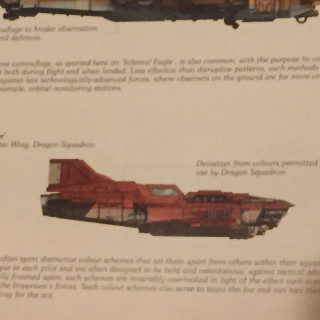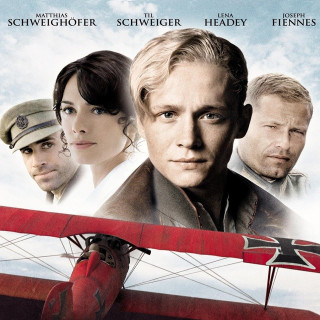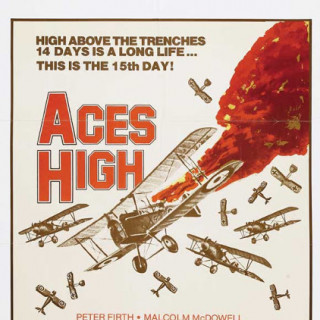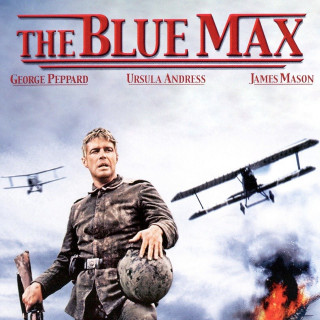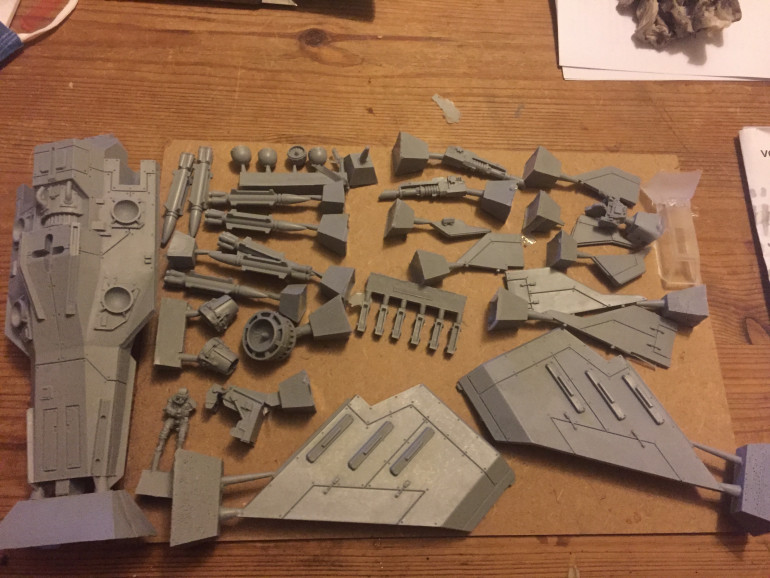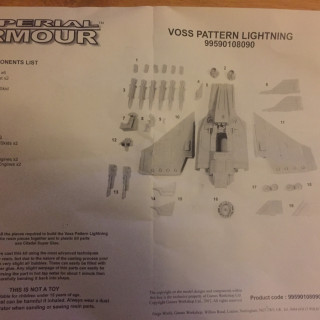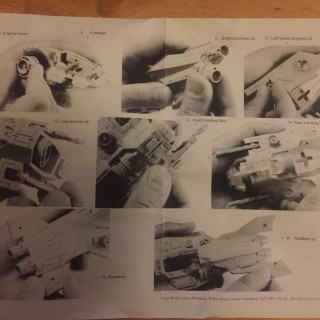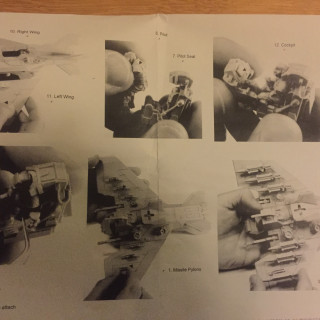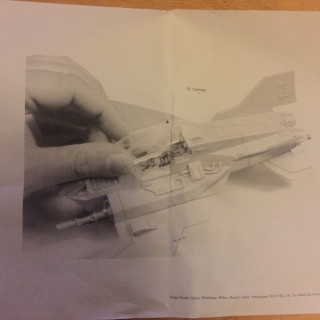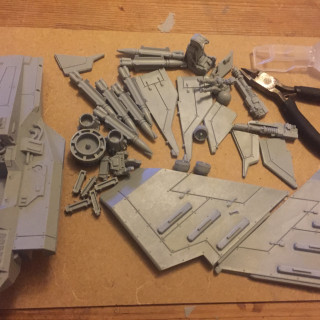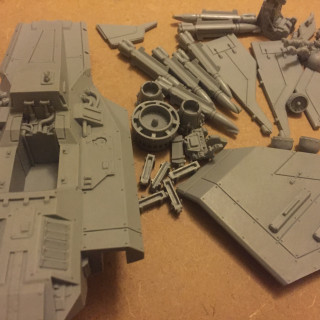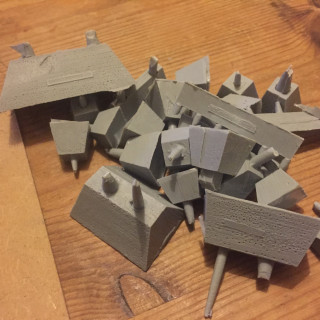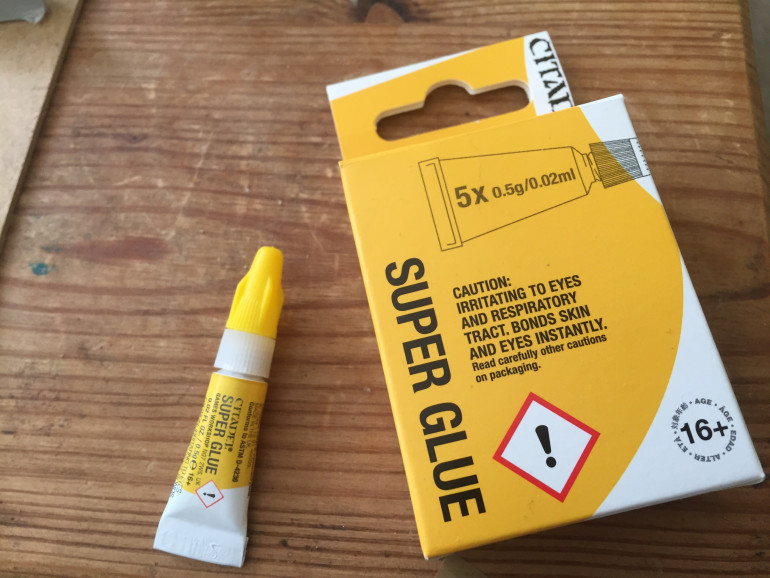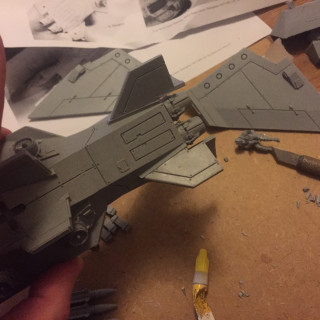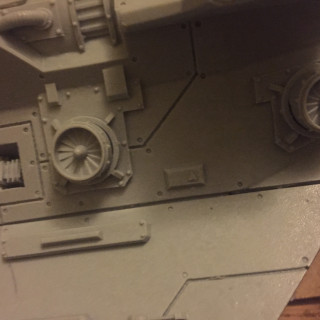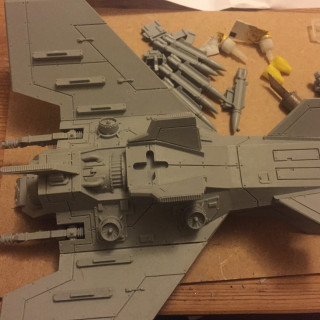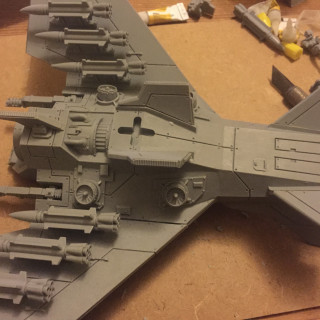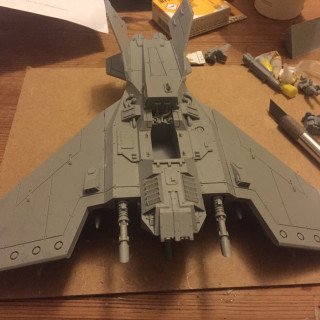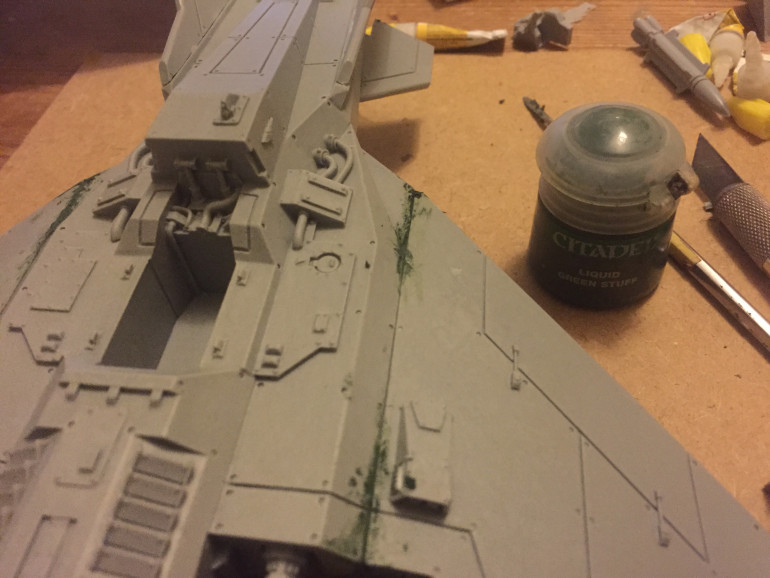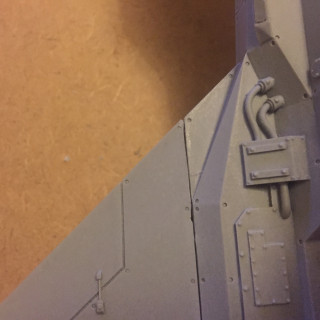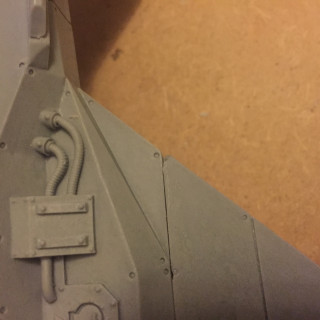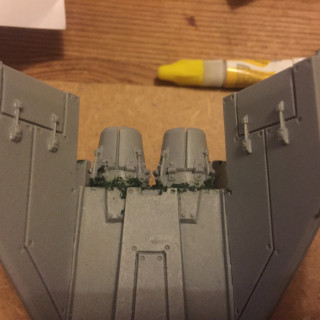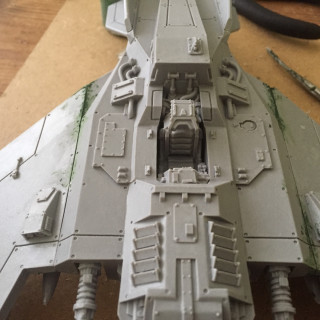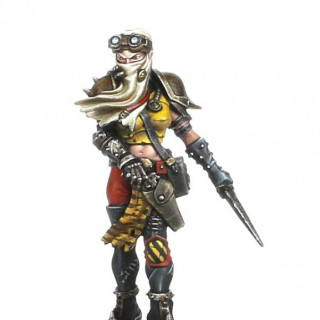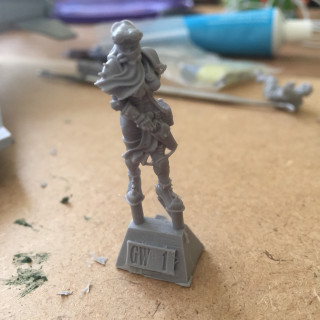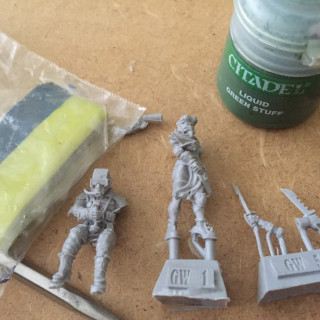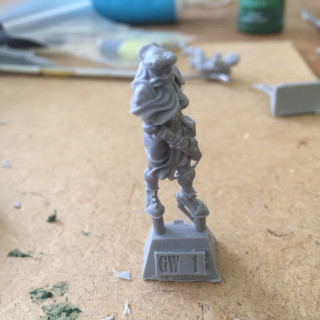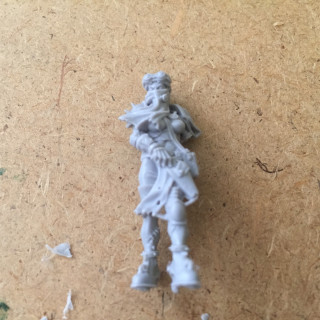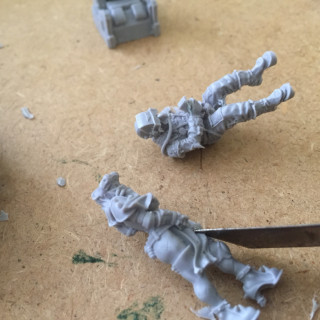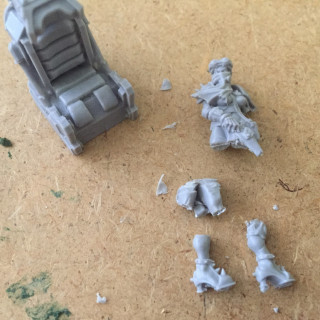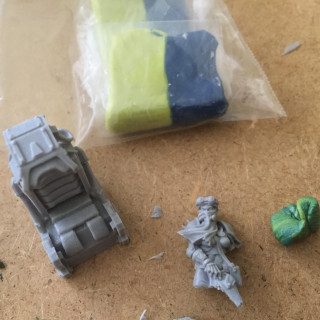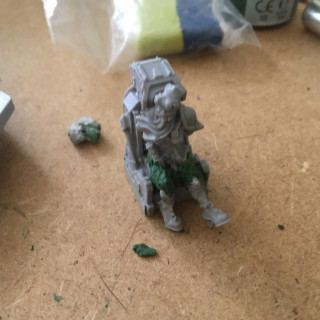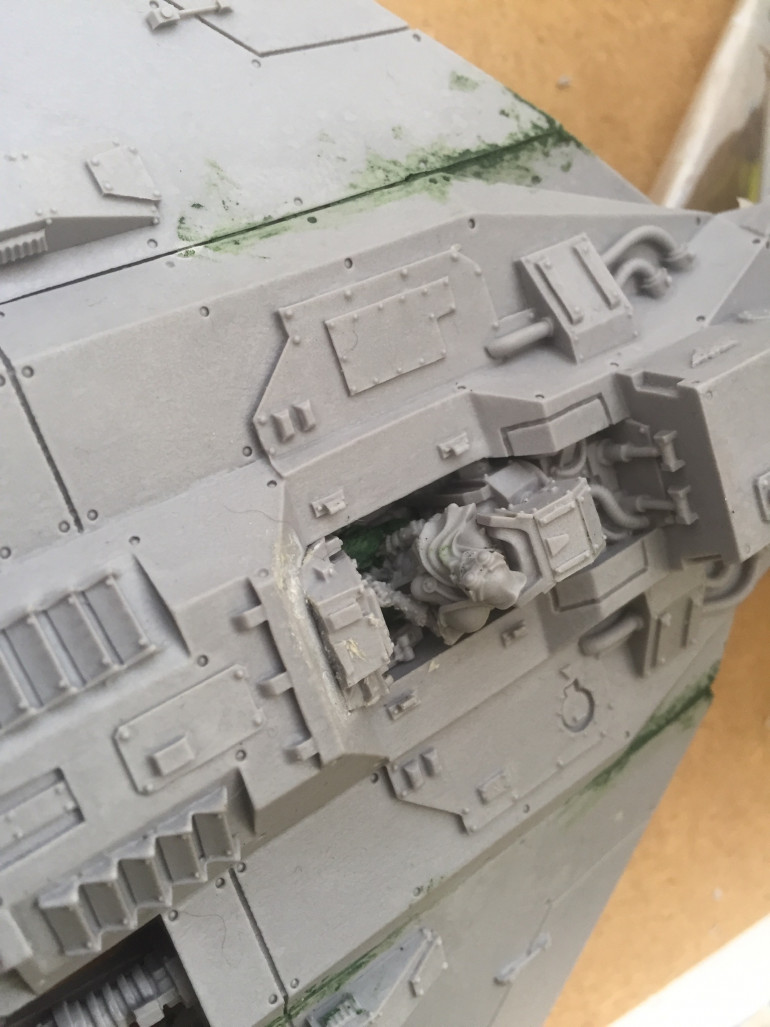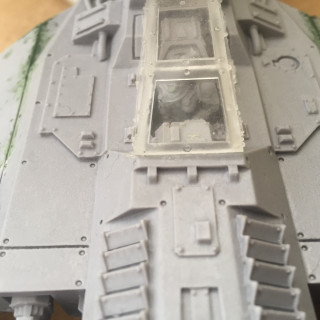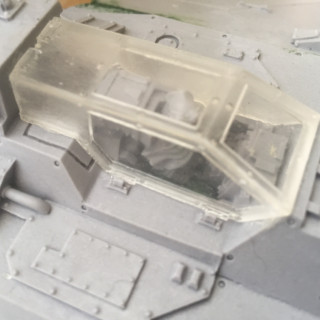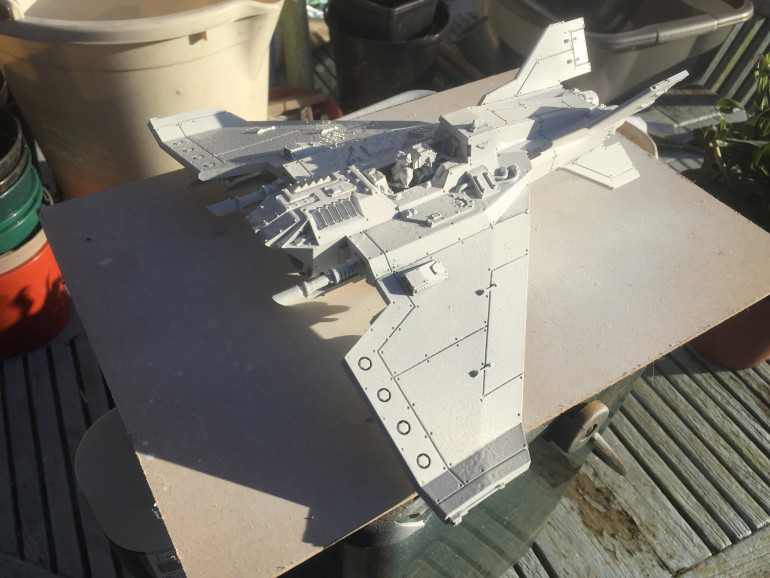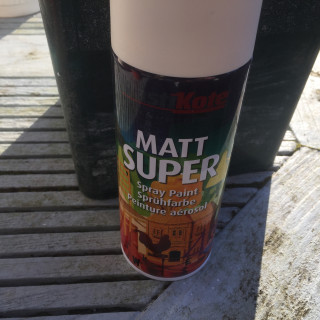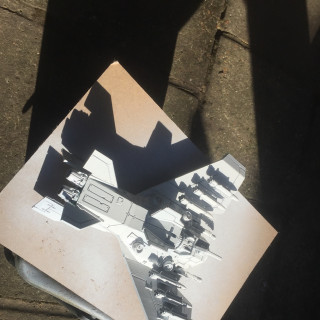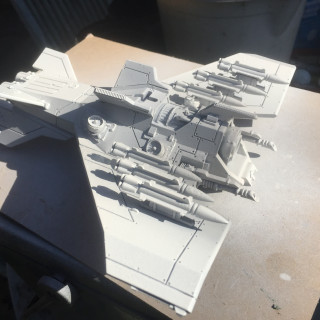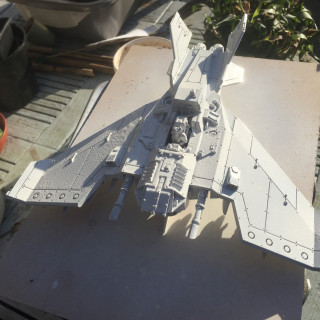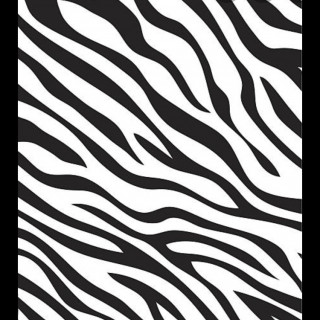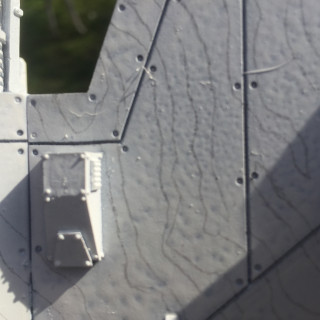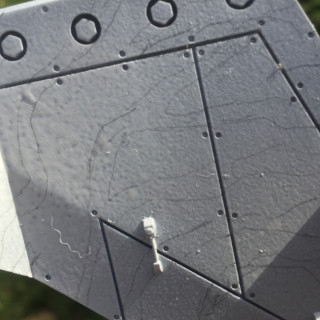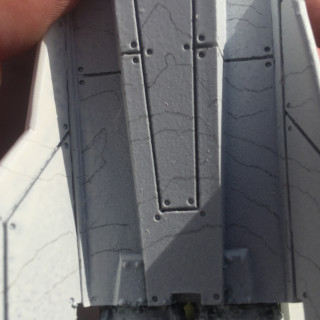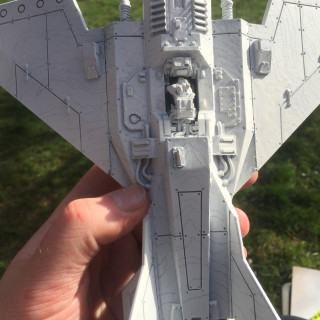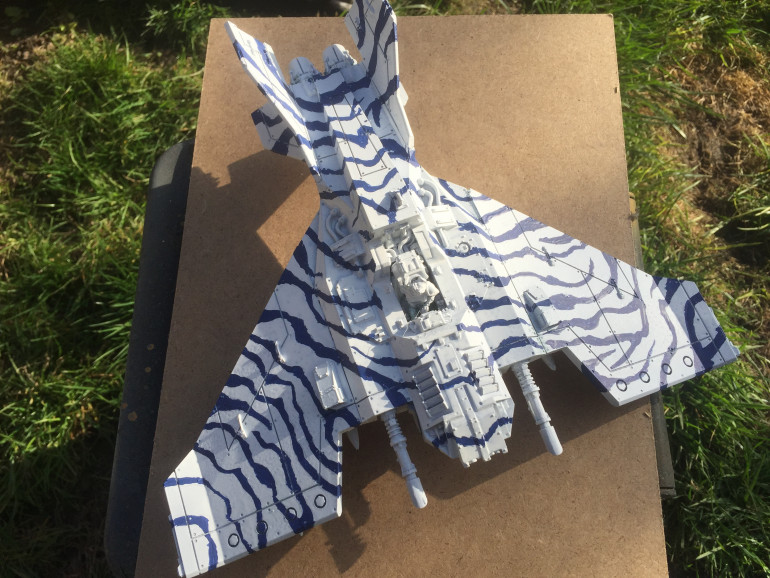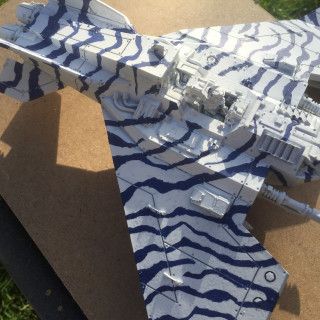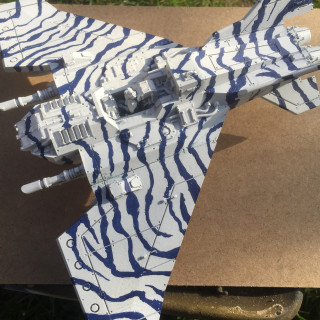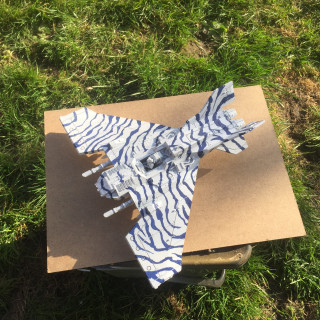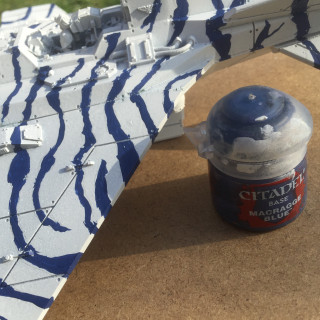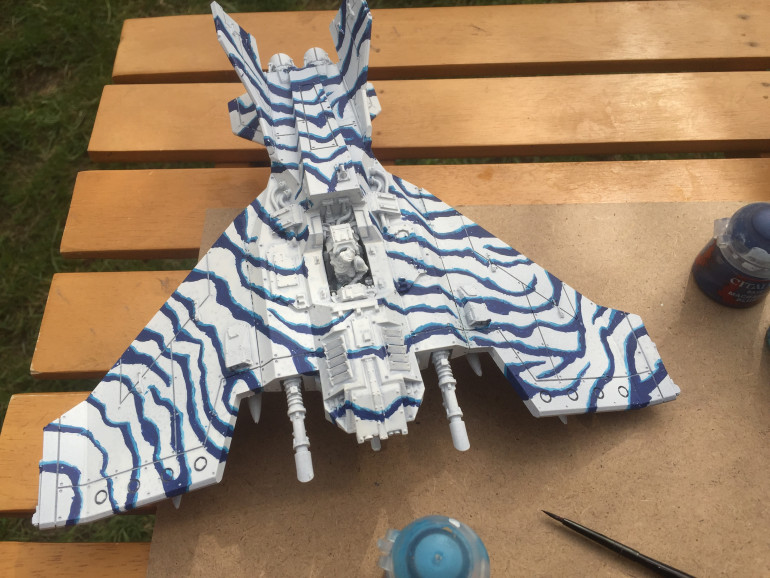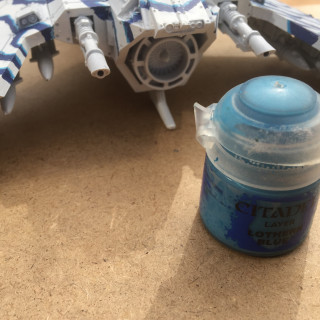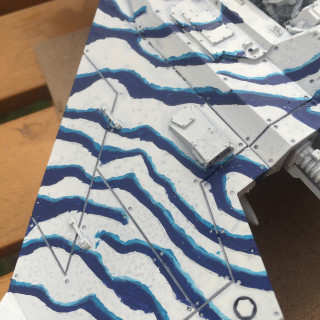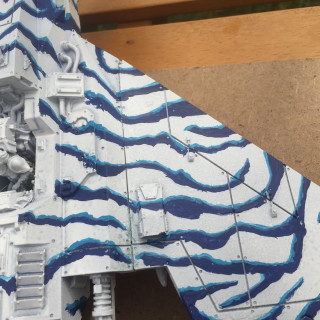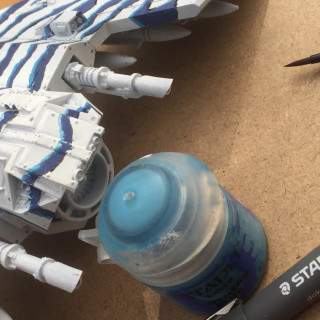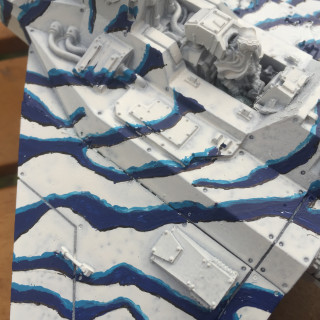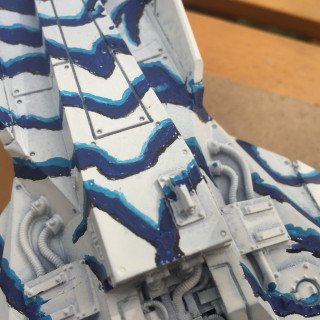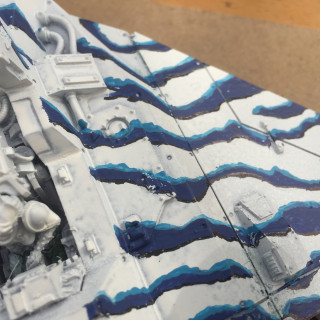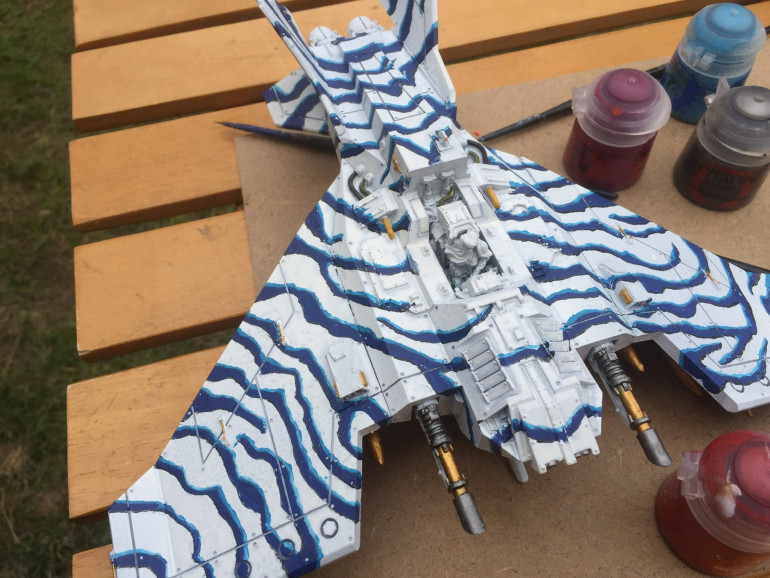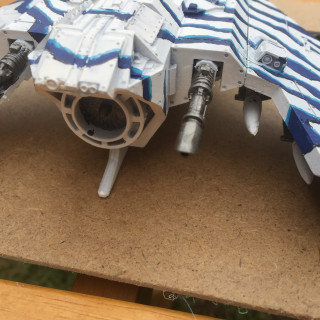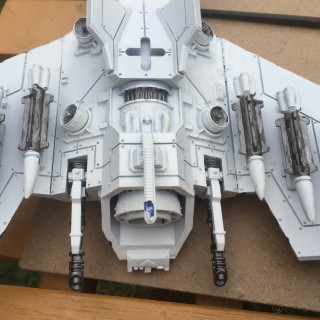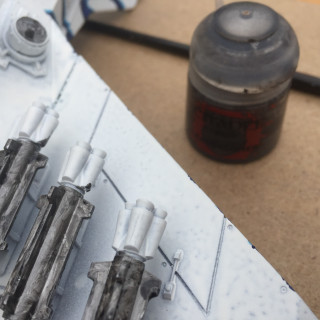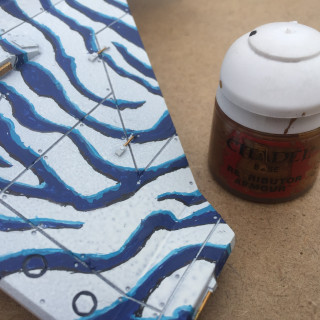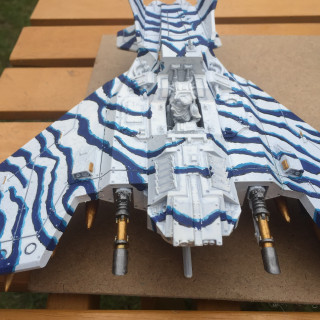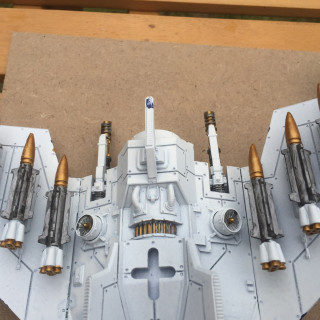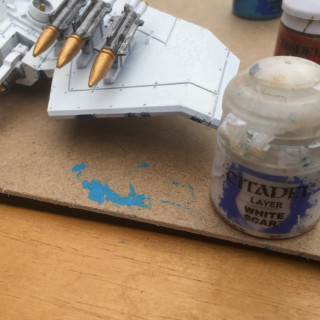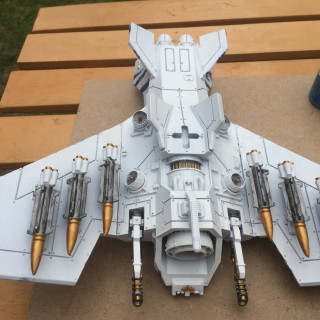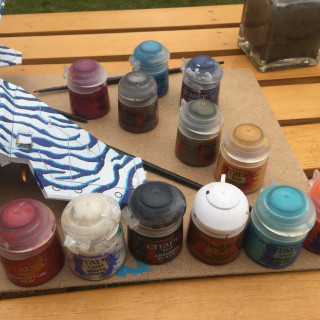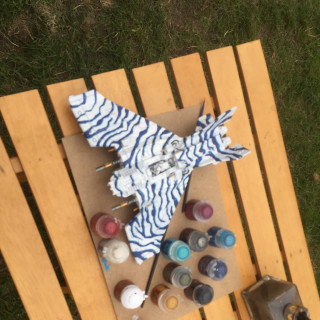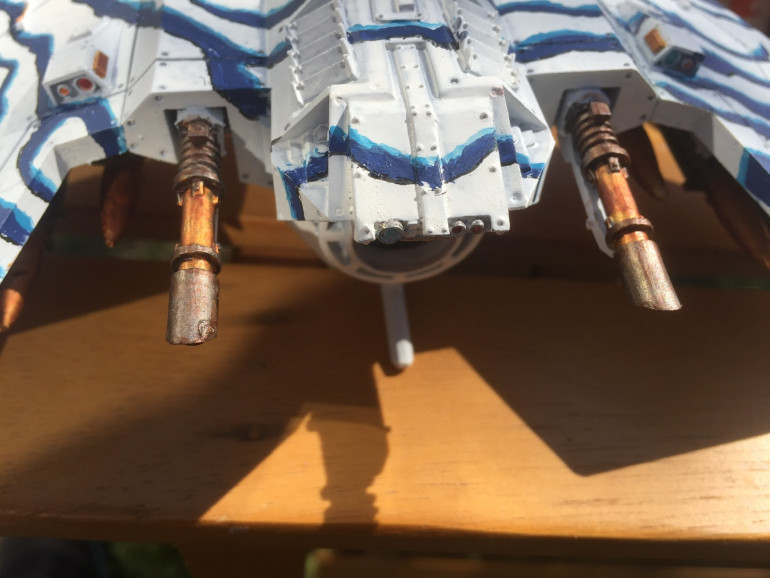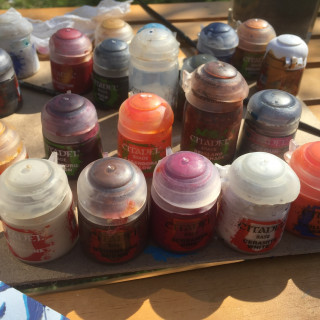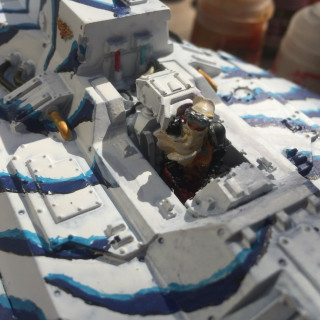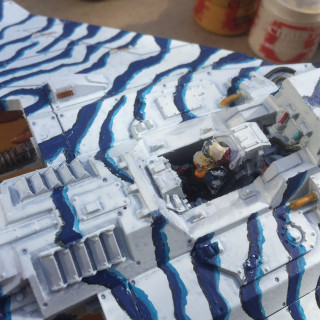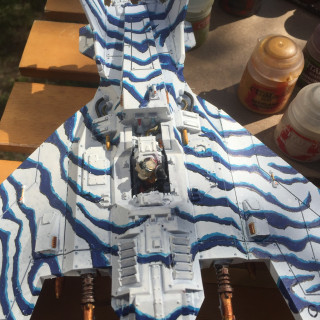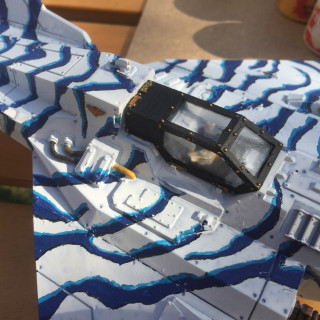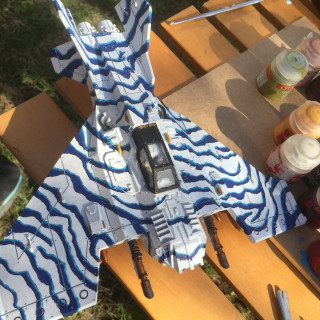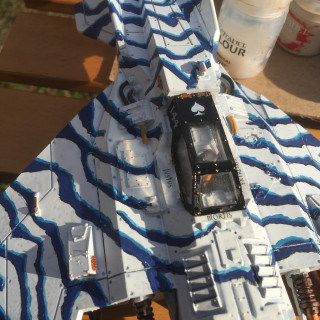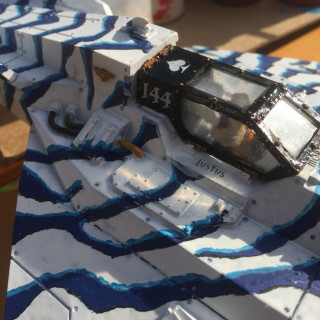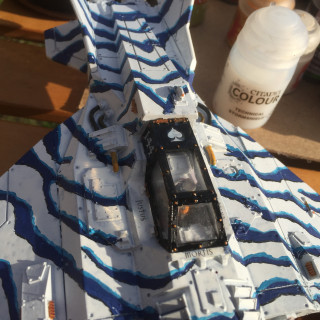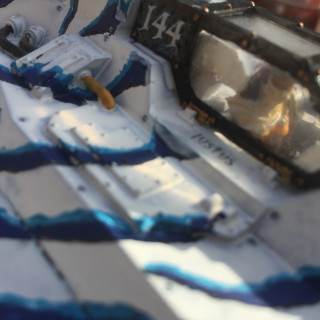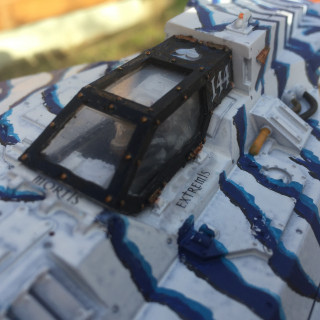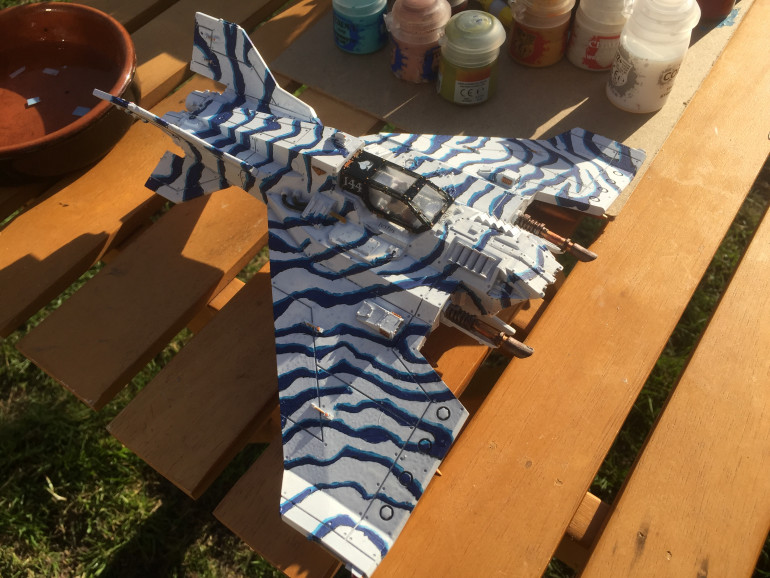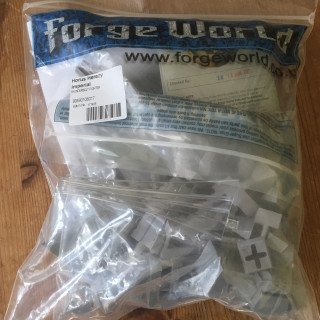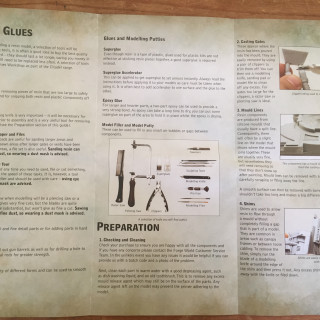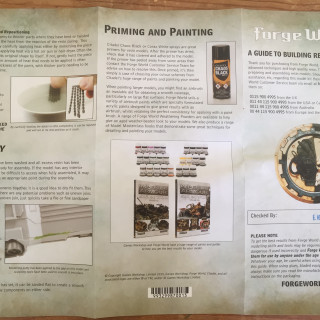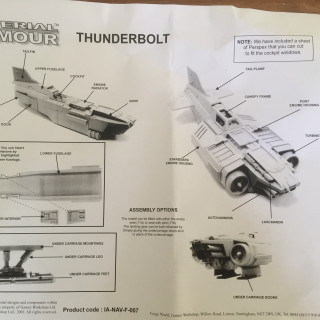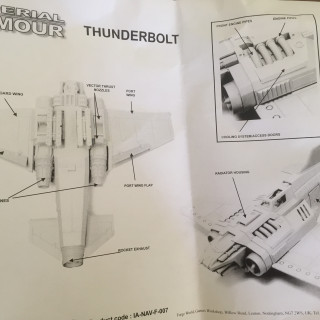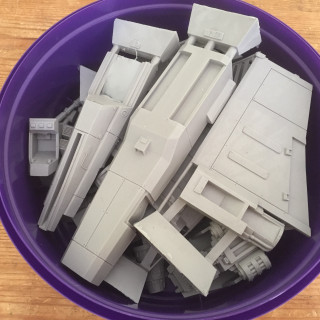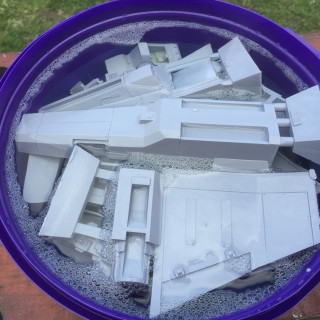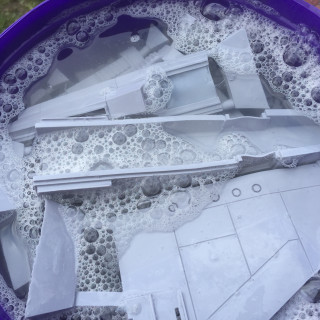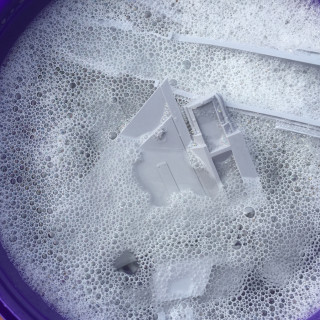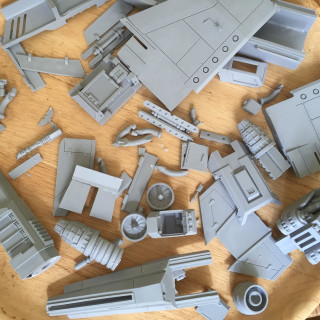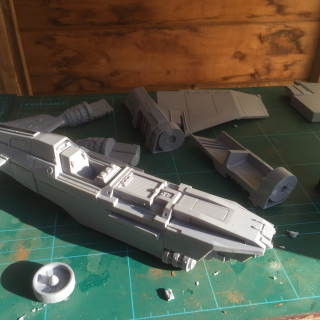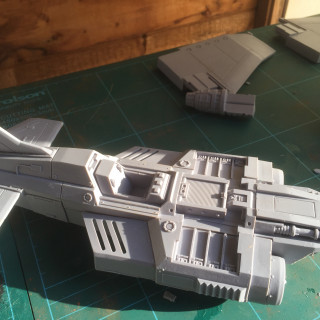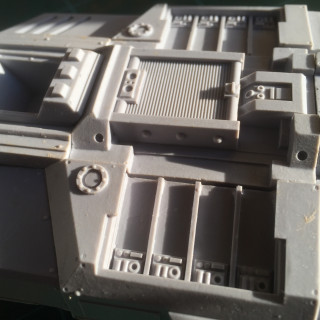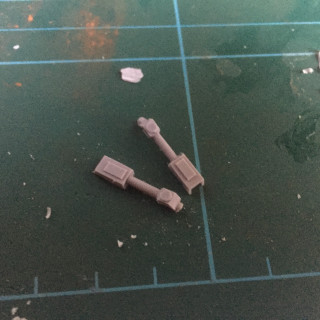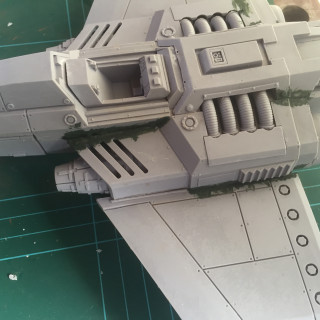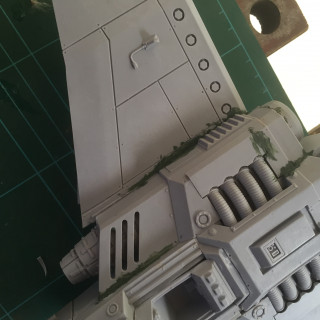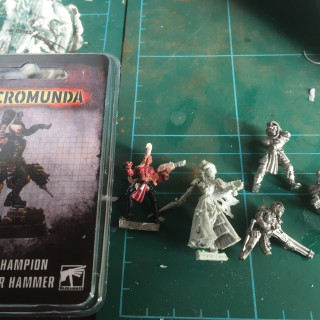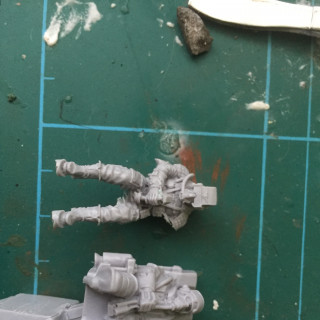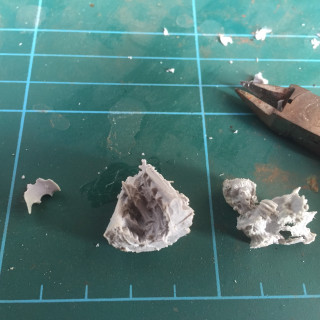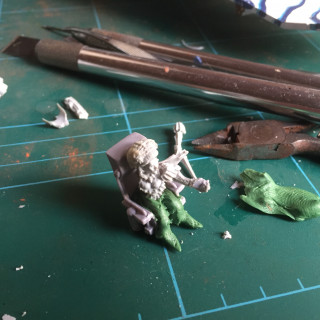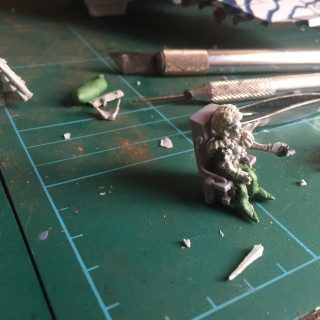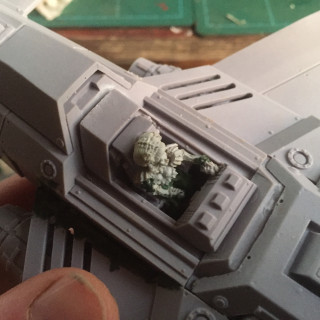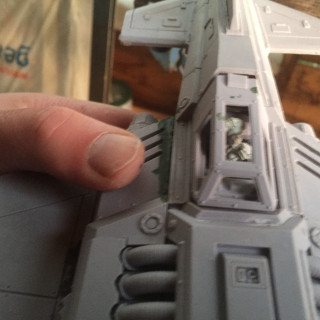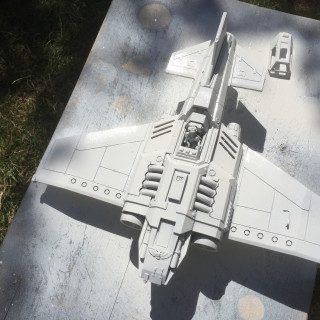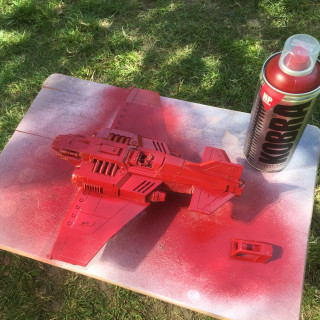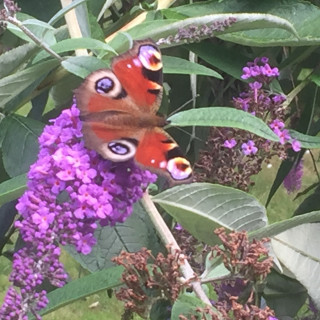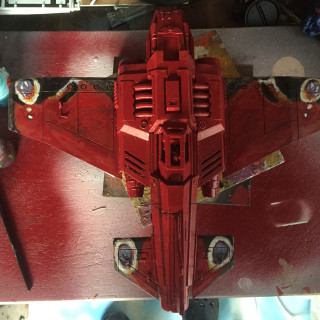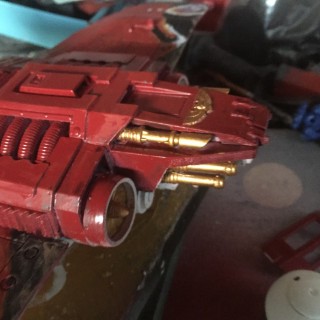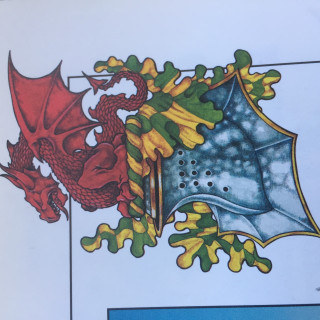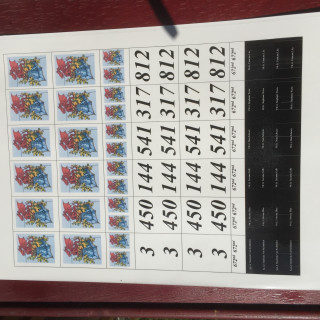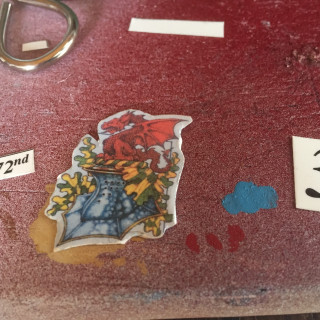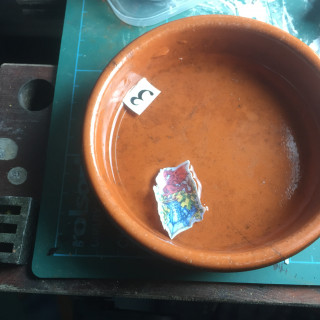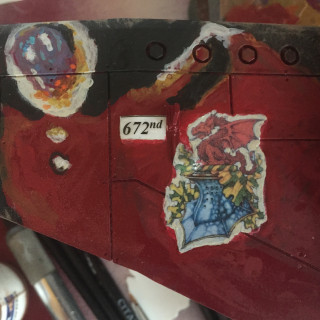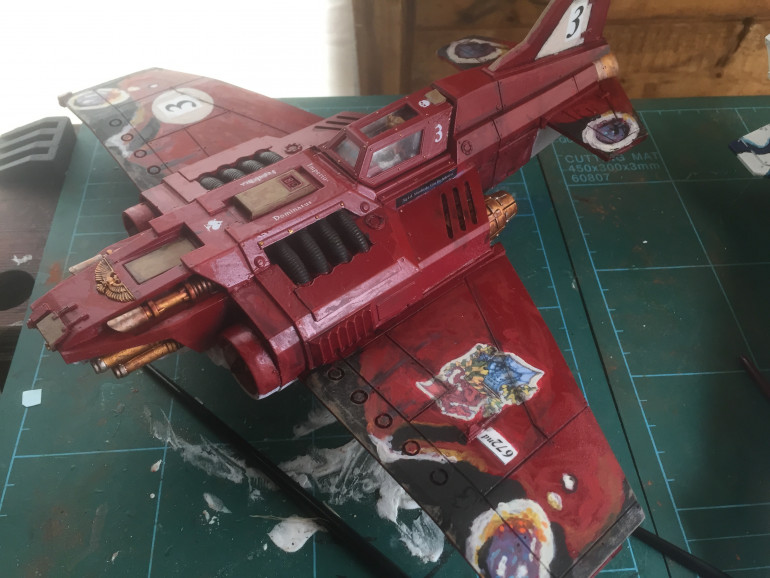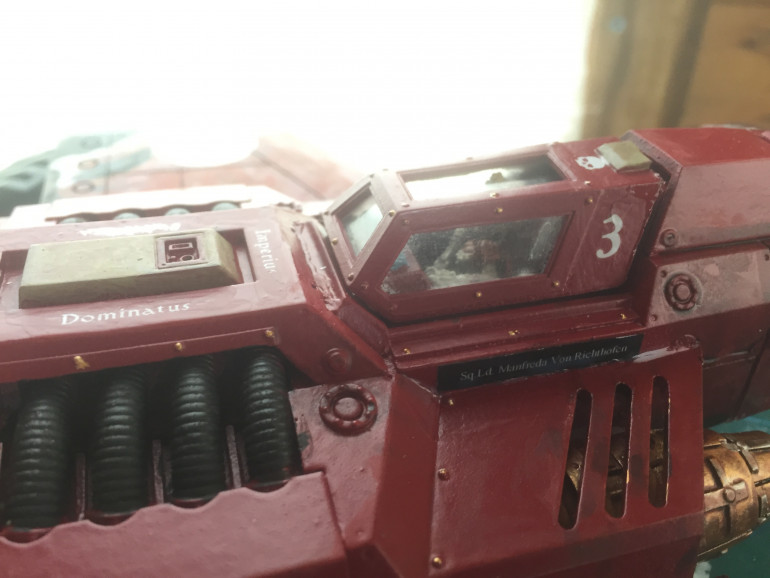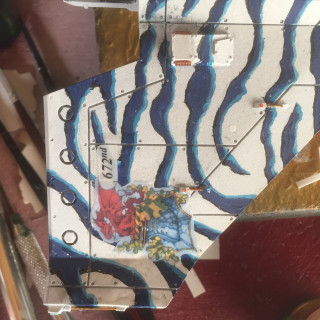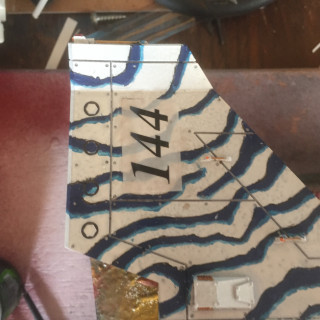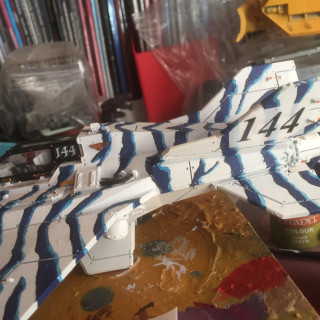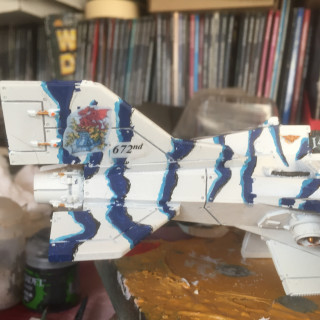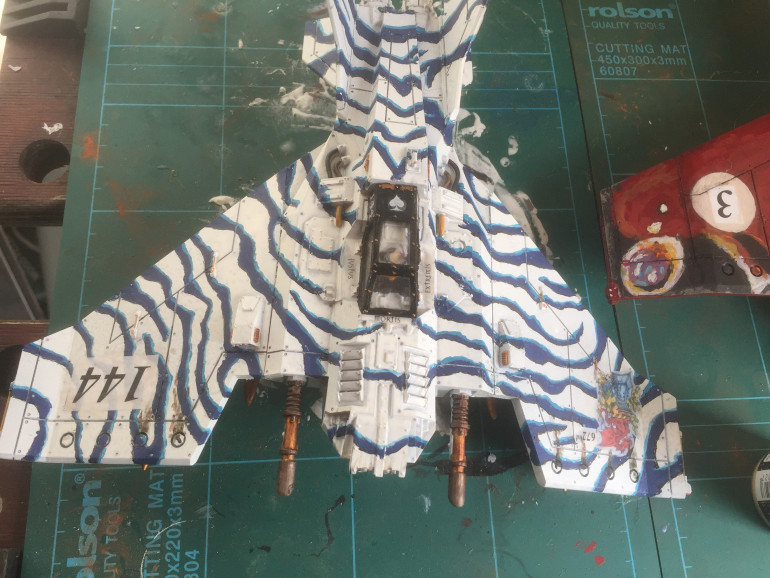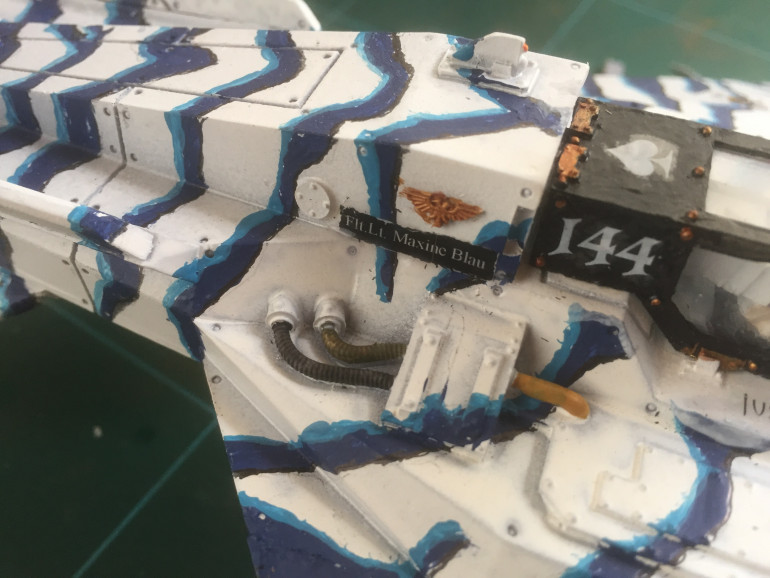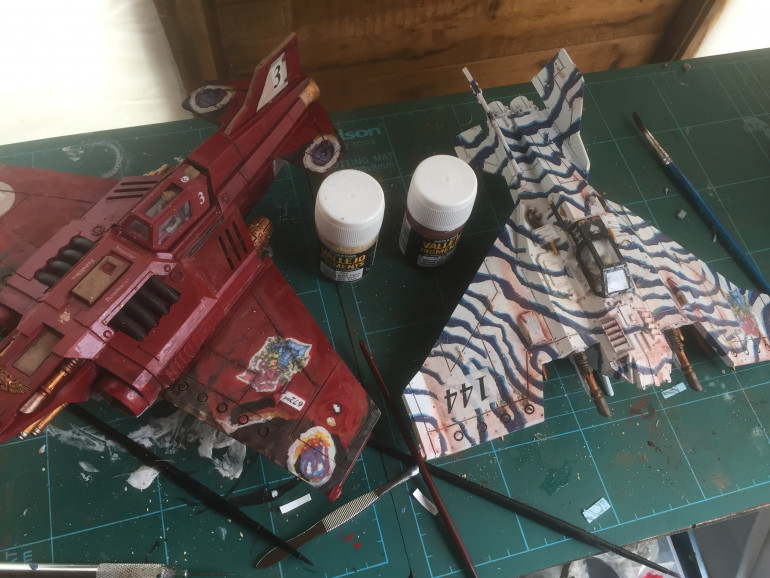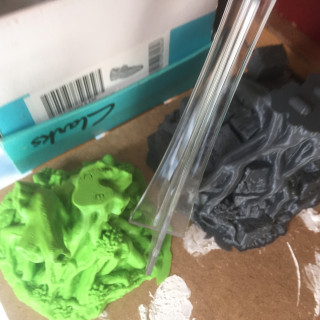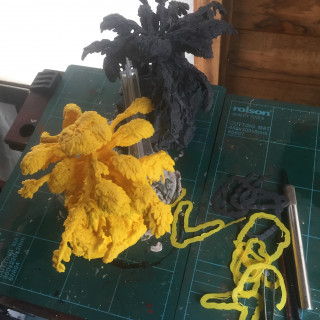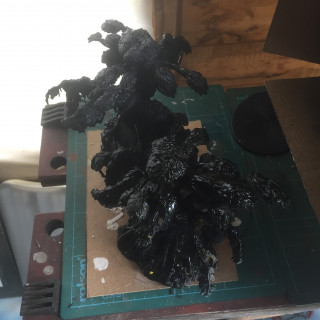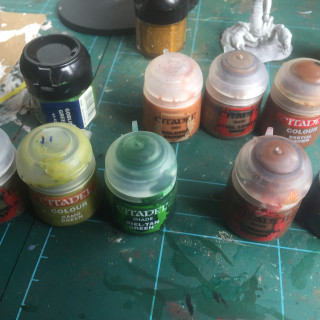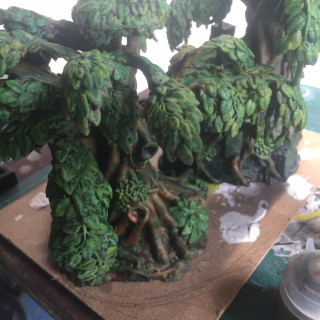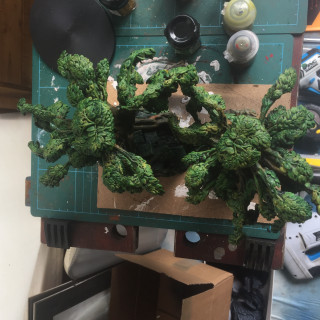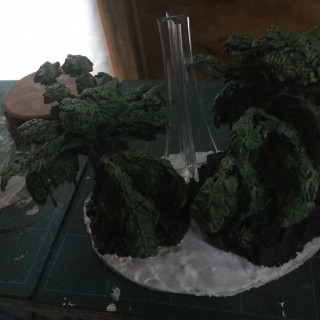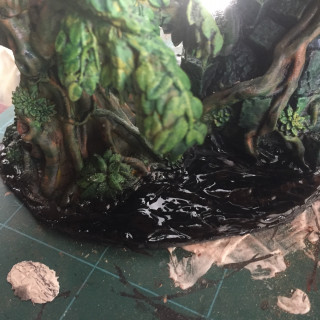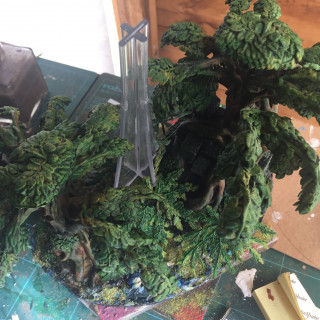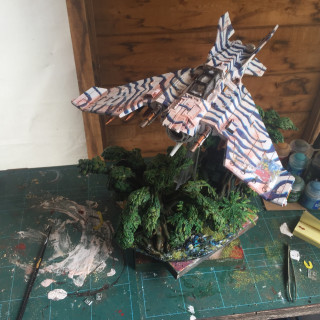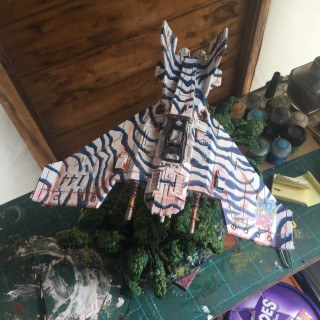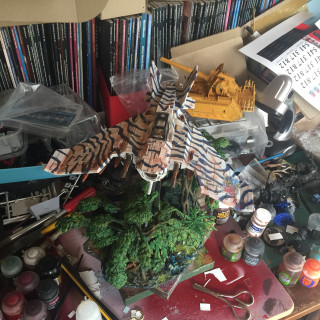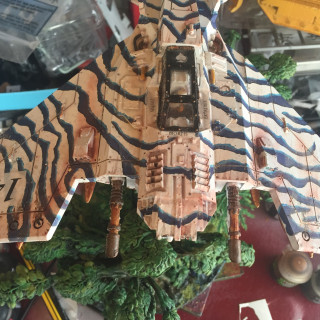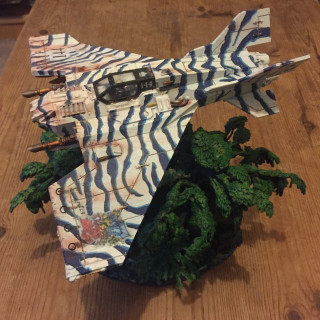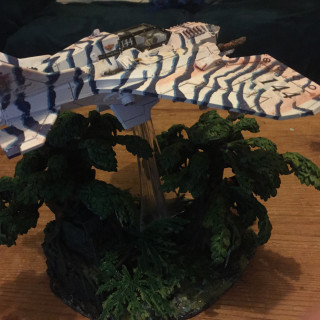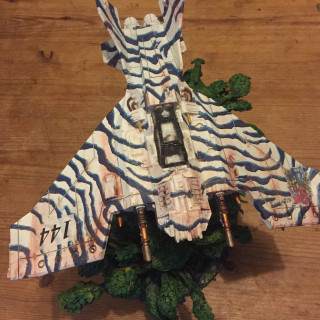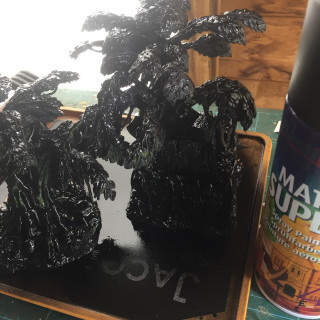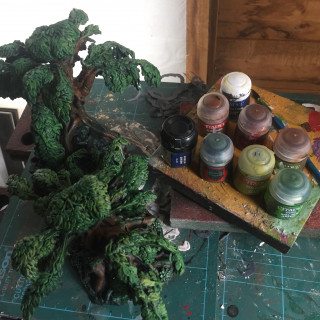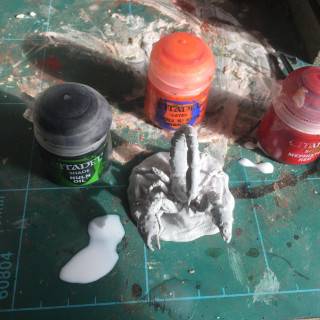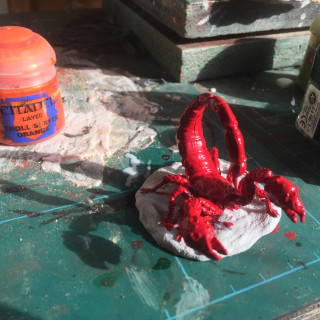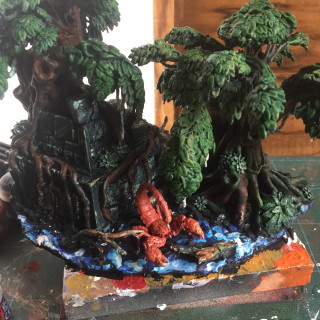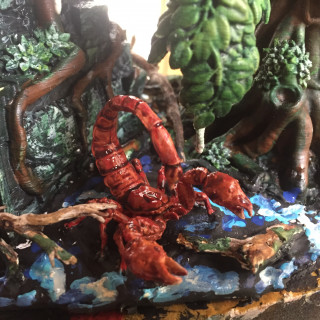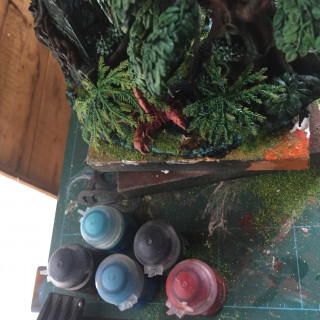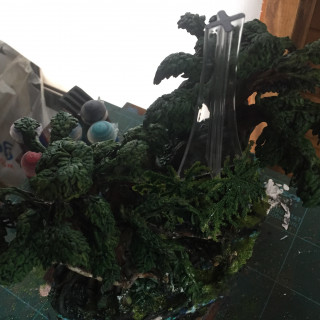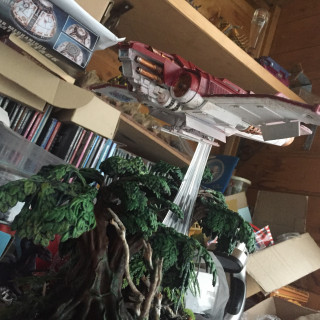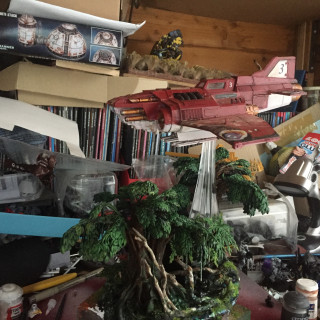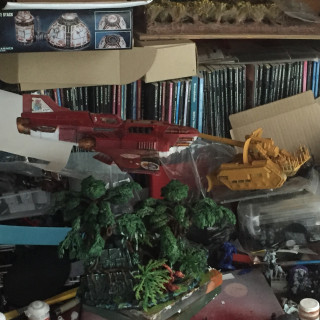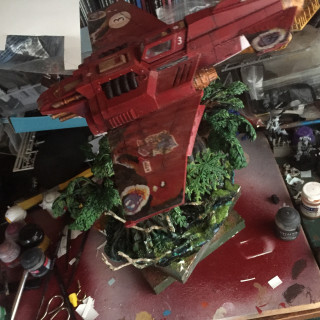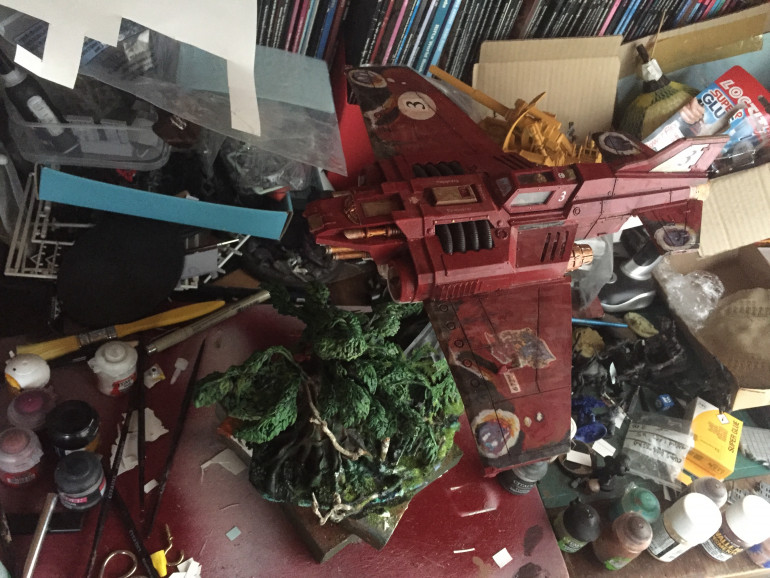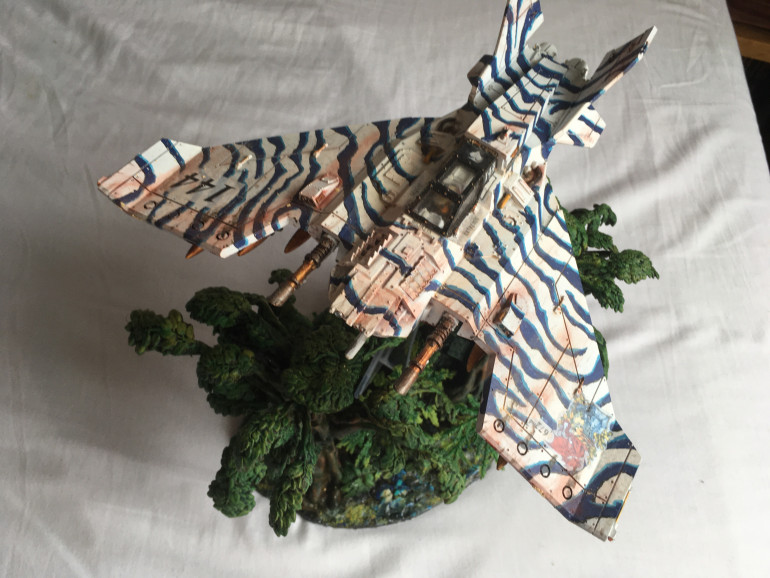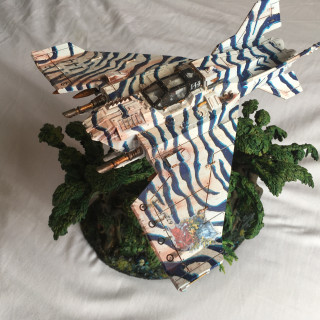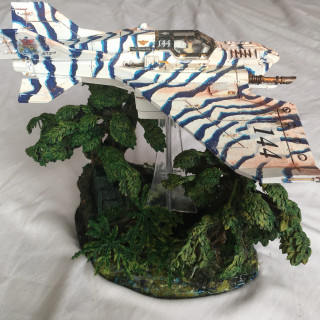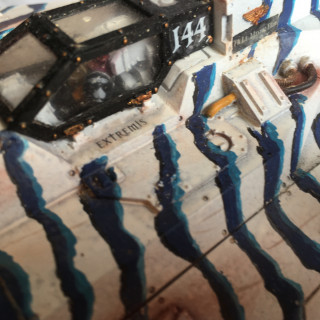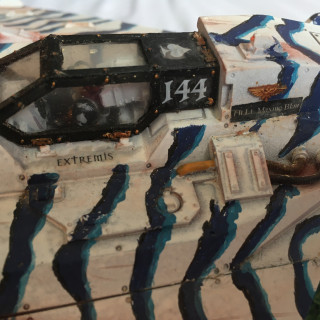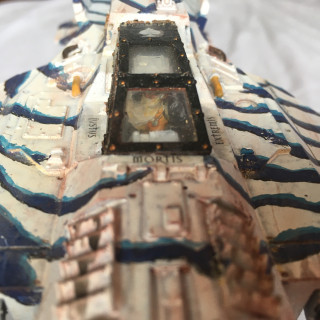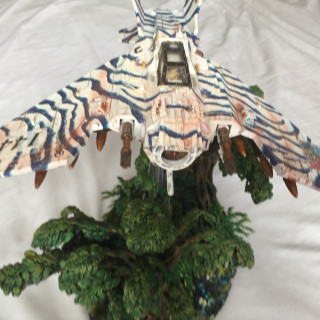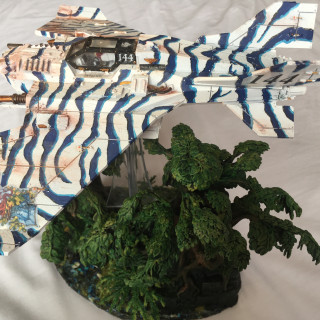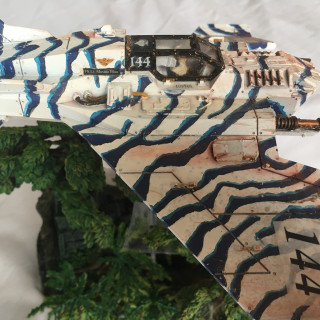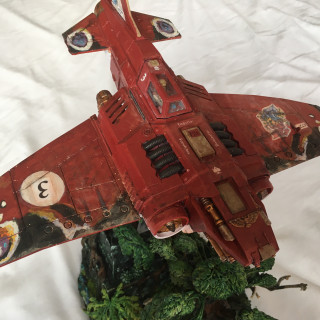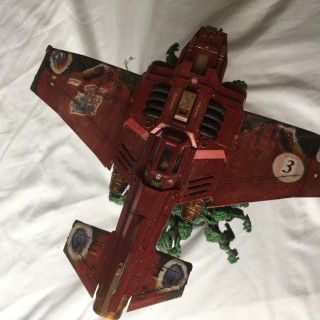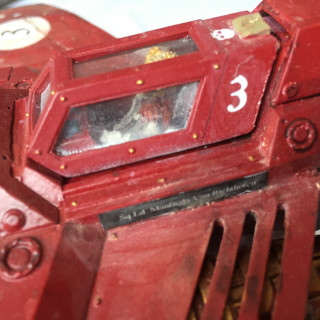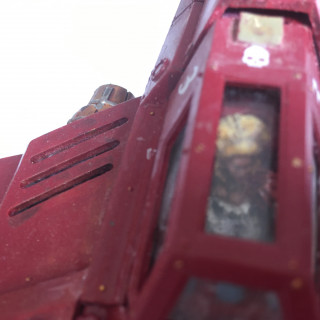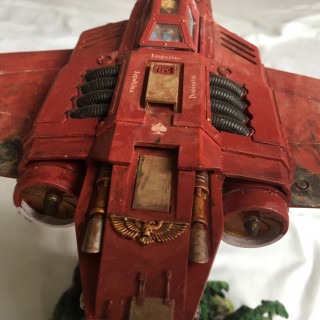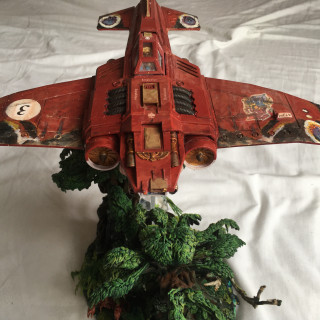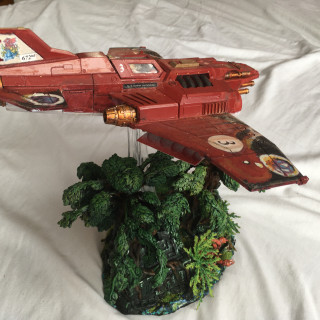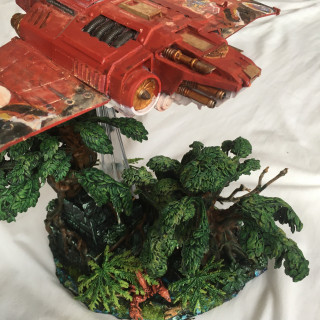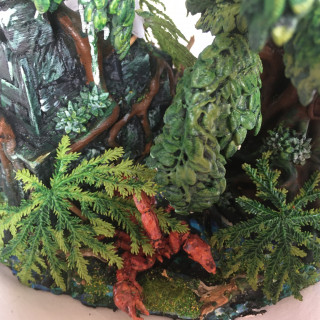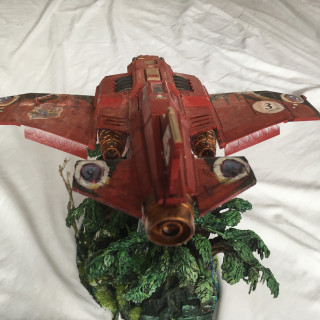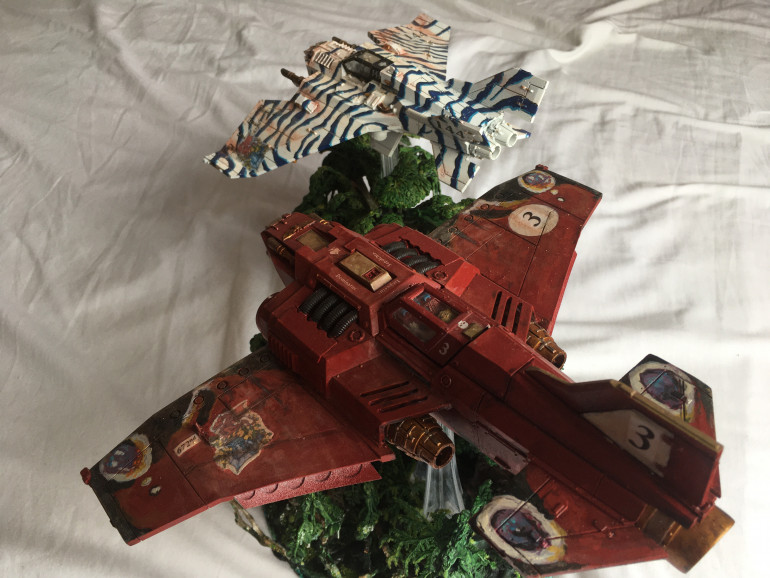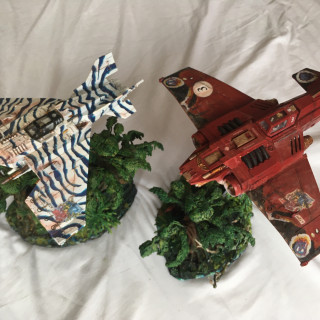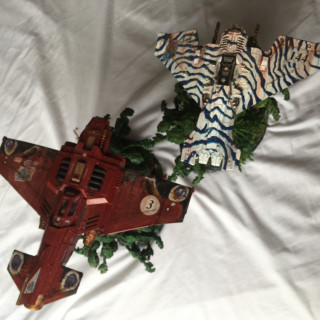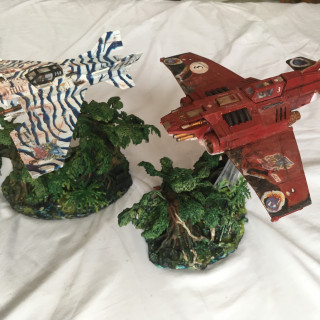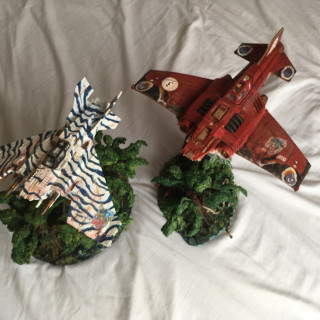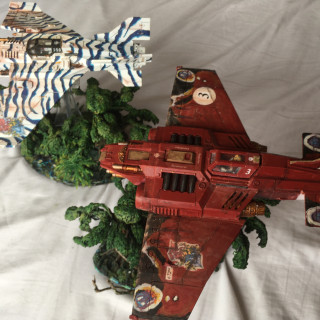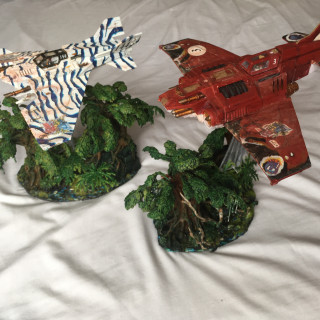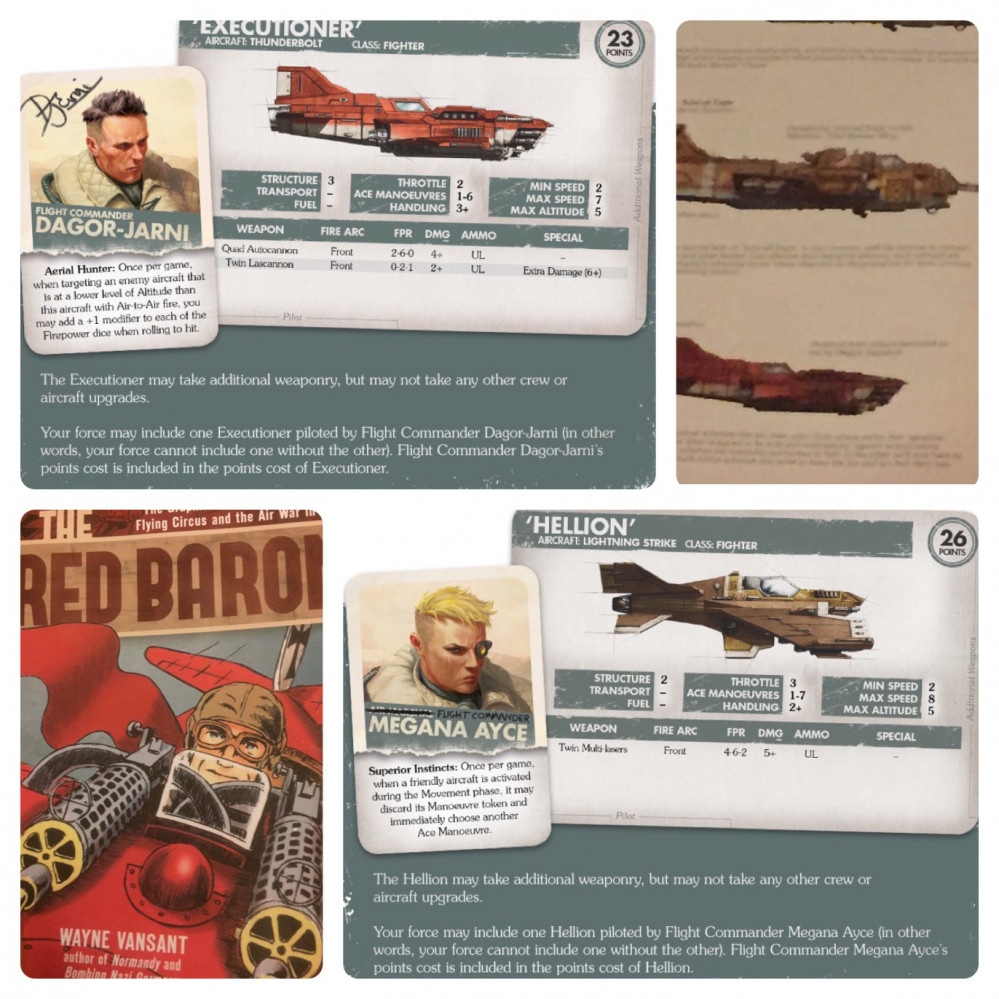
672nd Fighter Wing, Red Dragon Squadron Imperial Navy – “The Red Baroness” (SPRING CLEAN CHALLENGE 2021 by Zebraoutrider)
Recommendations: 220
About the Project
Time for a new Astra Militarum project. This time I’m taking to the skies with some fast air support for my various tank divisions for Warhammer 40K. This project initially involves the preparation, construction and painting of a Forge World Lightning Strike Fighter and a Forge World Heavy Thunderbolt Fighter. As with my usual style, I will be customising the craft and their pilots so that I have a couple of unique pieces to capture my interpretation of “The Red Baroness” and her “wing-woman”. This is a slow-burn project towards the eventual BOW/OTT Spring Clean Challenge 2021.
Related Company: Games Workshop
Related Genre: Science Fiction
Related Contest: Spring Clean Hobby Challenge (Old)
This Project is Completed
Project Inspiration
As with all my projects I need inspiration. I’ve also learned from 2020 to not be over ambitious as it can affect my motivation to complete large scale projects. I’ve still got two active projects open-ended, but really enjoyed painting up Commander Glofski’s Tank Squadron last year as the Spring Clean Challenge, that I’m creating a new project which will require similar effort and won’t drag on. Hence, after reading an article on the Warhammer Community website on Imperial Navy Heroes, I have dug out my latest unmade models to join my collection – Forge World’s Lightning Strike Fighter, Thunderbolt and a couple of Necromunda characters to convert into the pilots…
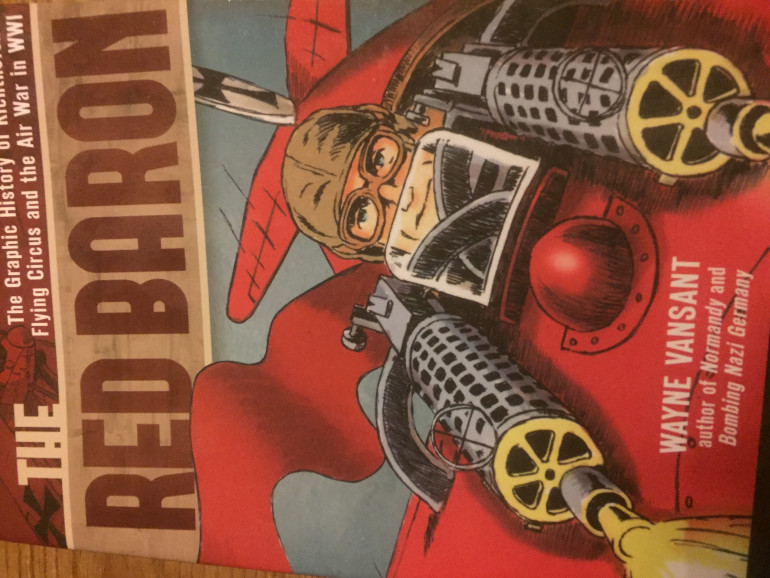 Inspiration has come from the graphic novel by Wayne Vansant (2014) on the history of the Red Baron, but also from the WW1 films of the Red Baron and the Blue Max. Further inspiration came from reading about a couple of fighter pilot aces in a White Dwarf article that actually was geared towards the Aeronautical Imperialis (small scale/epic) GW game.
Inspiration has come from the graphic novel by Wayne Vansant (2014) on the history of the Red Baron, but also from the WW1 films of the Red Baron and the Blue Max. Further inspiration came from reading about a couple of fighter pilot aces in a White Dwarf article that actually was geared towards the Aeronautical Imperialis (small scale/epic) GW game.Voss Pattern Lightning - Out of the box
First up in this 2021 Spring Challenge is the Voss Pattern Lightning. Accordingly to the 40K fandom, this is a much faster fighter than the Thunderbolt and the version available through Forge World is the ‘newer’ build. I can only find the older version with different wing configuration on eBay at exorbitant prices (or on sites which make me think they must be counterfeit as they are far too cheap!) Anyhow, this is a 19 part kit and the solid parts mean that there is little warping of the resin components.
As with all resin models, it’s necessary to wash the parts in soapy warm water to remove the mould grease and to rinse the parts and dry. Now one could ignore this, but it will affect the painting of the constructed model even with spray under coats. It’s also a useful task as you can check all parts are present and that there are no defects. I discovered my kit came with an extra hellstrike missile… something for my bits box for free ?.
Having cleaned and left to naturally dry over a couple of days, the next phase will be to remove the excess flashing and resin off cuts that are created in the manufacturing process. There’s a lot of of excess resin sprue bits to remove… ?
Project Time taken:
Reading and figuring out instructions and checking all components for defects: 1 Hour
Cleaning components: 1 Hour
Natural Drying: 48 Hours
Sitting in awe at components: 72 Hours
Voss Pattern Lightning - Preparation of Components
So, next up is the preparation of the components. I would suggest carefully looking at how the excess sprue connects with each piece to ensure that you don’t clip off too much or damage the fine detail of the component. Double check before cutting the parts.
I used a Citadel pair of clippers throughout this process but where there were large chunks of sprue I cut from different sides until the excess snapped cleanly off. Once all excess chunks were removed (I could keep them as battle debris for basing?), I could then revert to a modelling knife to carefully slice back any further excess to ensure a smooth finish to both the external appearance of the components and the hidden tabs that will glue into the various recesses as the construction builds.
Take your time in the preparation here! This kit cost £89, and unlike any Lego kit, they don’t throw in spare components.
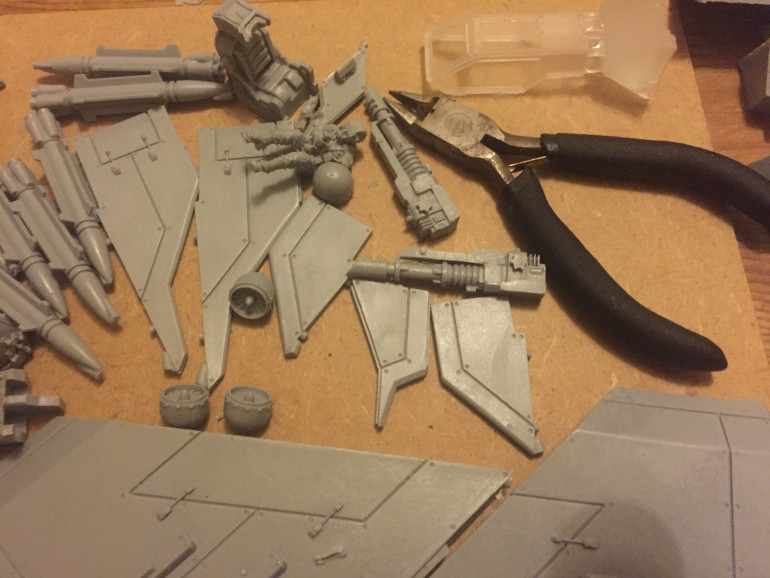 Preparation of components - take your time and double check you are not damaging the detail before you make the first cut!
Preparation of components - take your time and double check you are not damaging the detail before you make the first cut!Time taken:
Cutting/Clipping of Excess Sprue (including careful checking of each cut) 1 Hour
Fine cutting of excess around tabs and external detail 1 Hour
Voss Pattern Lightning - Construction
Now comes the best part… construction! I’m using Citadel super glue. This is a box of five 0,5g gel tubes and at £5 for the box, you can get cheaper on the market and indeed I used two full tubes on the core construction of the Voss Pattern Lightning. On a plus side, you do use all the glue and none goes to waste which can happen with larger liquid bottles or tubes that go hard as the glue cures once opened.
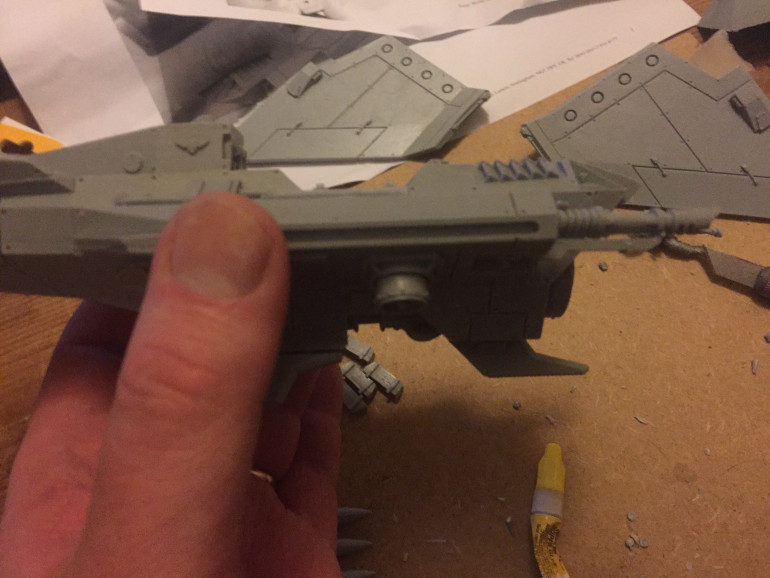 Before using the glue, marry up the components to ensure they fit correctly and carefully adjust as required with a modelling knife and check fit again before gluing. Hold together for at least 60 seconds (without shaking). This kit does not require extra pinning of the components.
Before using the glue, marry up the components to ensure they fit correctly and carefully adjust as required with a modelling knife and check fit again before gluing. Hold together for at least 60 seconds (without shaking). This kit does not require extra pinning of the components.One typical issue with resin kits (especially in my experience with FW kits) components don’t always perfectly fit. This means you will need to use some liquid green stuff to fill the gaps that are created. Now these are only 1-2mm gaps and so using a dental/sculpting tool, it’s fairly easy (with a still hand) to fill the gaps without destroying the detail.
The rear exhausts, the top side of where both wings attach to the main body of the Voss Pattern Lightning, and one side of the underneath of the wing needed some attention. Again, take your time.
Note, the pilot’s seat has not been glued in, but has had the excess filed down to ensure a snug fit. I will be removing it to make a customised pilot which I will glue into the seat before reinserting back into the main body of the Lightning. The canopy will remain detached and painted separately until the very end once the craft and pilot have been painted.
Time taken:
Construction (gluing) 2 Hours
Gap filling with green stuff and drying time 1 Hour
Voss Pattern Lightning - Kit-bashed Pilot
I like to customise my models and so for the Voss Pattern Lightning I’ve decided to ditch the current pilot (looks like an Elysian) and I’m going to hack apart a Necromunda FW Hired Gun to reposition from standing to sitting. This means out with the liquid green stuff again and the two-part green stuff putty to recreate the bits I have to remove to enable the repositioning. Sculpting tool at the ready.
I needed to chop the Hired Gun at the knees and waist, but also needed to remove her buttocks to reposition the legs and resculpt with green stuff. I’m not too worried about the cosmetics as she will be part hidden from the waist downwards once installed in the cockpit. The right arm is in a similar position to the original pilot while the left arm will have the dagger removed and will also be added and glued in place using tweezers once the pilot is installed (just like the instructions if using the original pilot).
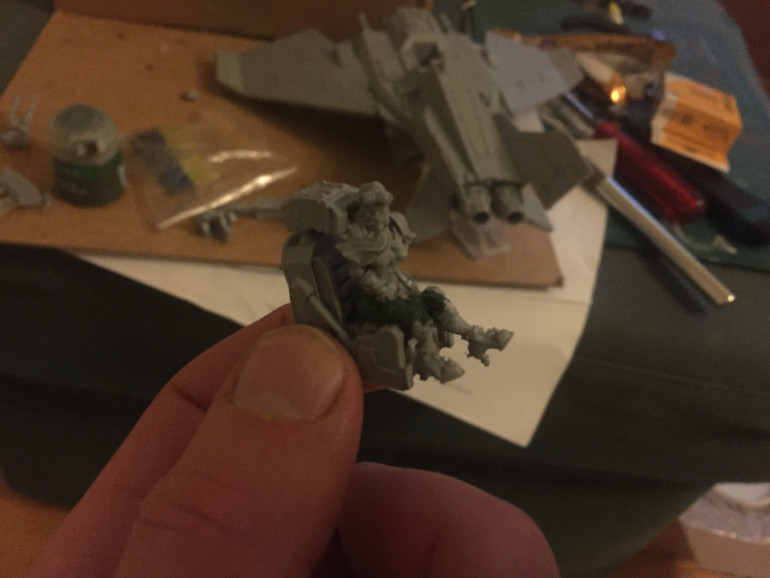 The new pilot has been repositioned and fixed into the original seat which will be fitted into the cockpit along with the control panel and the Hired Gun’s left arm once the green stuff has fully dried over night.
The new pilot has been repositioned and fixed into the original seat which will be fitted into the cockpit along with the control panel and the Hired Gun’s left arm once the green stuff has fully dried over night. Next up will be to install the pilot into the cockpit and prepare for painting.
Time taken:
Construction of new, kit-bashed pilot including resculpting legs 1 Hour
Drying time for green stuff putty 24 Hours
Voss Pattern Lightning - Pilot on board and Undercoating
Installing the pilot was a little bit more tricky than I had imagined and this was largely due to ensuring the display panel could be inserted and pushed down correctly to enable the cockpit roof to be fitted. However with a bit of brute force, superglue and tweezers to secure the left arm, she was finally installed!
Painting the Voss Pattern Lightning could now begin and this means undercoating with a Matt spray paint. I contemplated using black as this will provide appropriate shading in the recesses, but as I want to use fairly striking shades of colour, I opted for a white undercoat. I’m using Plastikote Matt White because 1) it’s served me well in the past and 2) it’s half the price of Citadel Paint Spray cans.
Make sure you spray in a well ventilated room or as I did – outside. Liberally spray the underside first at a distance of around 6 inches and leave to dry for around 30 minutes before turning over the model and spraying the top. I suggest spraying from various angles to ensure all areas are covered. Again leave to dry.
Note, the cockpit roof was not stuck down during the construction and will be painted separately.
Next up will be to add colour and freehand designs to bring the Voss Pattern Lightning Fighter to life…
Time taken:
Pilot installation in cockpit 30 minutes
Undercoating including drying time 1 Hour and 30 minutes
Voss Pattern Lightning. - Zebra stripes camouflage base layer
I’ve decided that the Voss Pattern Lightning will be the wing partner to the Thunderbolt and scouting ahead like an outrider. The original Red Baron’s Squadron had multicoloured fuselage with each pilot able to customise their plane almost akin to a knight and their bespoke heraldry.
So, for the Voss Pattern Lightning I’ve decided on a zebra pattern for the upper side of the wings.
First of all I selected an appropriate image of a zebra skin pattern from the Internet and used that as a guide to drawing, with a sharp fine pencil, the stripes onto the wings.
Once the drawing was complete I selected Citadel Macragge Blue paint as the initial base colour for the zebra stripes. This fighter will be my interpretation of ‘The Blue Max’.
Next up will be to get a 3D effect into the stripes with further layering and highlights.
Time taken:
Drawing zebra stripes 1 Hour
Painting base layer of stripes 1 Hour
Voss Pattern Lightning - Zebra stripes camouflage highlights
The next painting challenge for me was to make the zebra stripes 3D. Now this is not an easy trick when painting 2D, so I used a technique whereby I painted one side of each stripe with a light border and the opposite with pure black.
I used Citadel Lothern Blue for the light highlight, while I used a very fine (0.1 nib) black permanent ink pen to define the dark border.
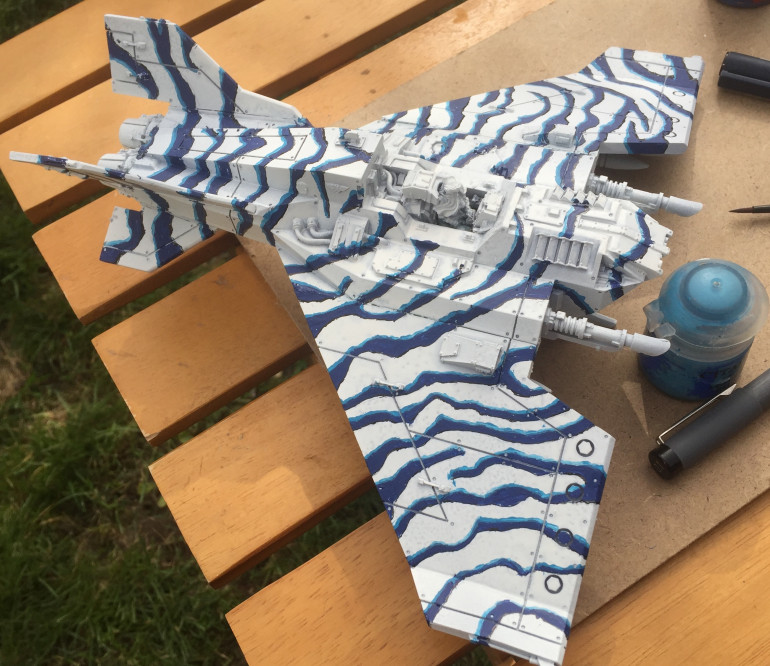 Dark highlights applied with a fine black, permanent pen to contrast the lighter Lothern Blue colour used.
Dark highlights applied with a fine black, permanent pen to contrast the lighter Lothern Blue colour used. Okay, so I’m happy with the overall effect of the stripes. I know as I progress, they will get toned down when I introduce oil and dirt washes and weathering. Next, I need to focus on the metalwork such as the weapons, front engine, exhausts and VTO engines.
Time taken:
Light Blue painting of zebra stripes highlights 45 minutes
Fine black line detailing of zebra stripes 45 minutes
Voss Pattern Lightning - Metalwork
Another nice Spring day in the sun and I’ve cracked on with the Voss Pattern Lightning’s guns and engines for all the metalwork bits and pieces. I’m using Citadel Retributor Gold and Leadbelcher as the main colours but also going back to white for touching up areas that need some attention.
To tone back and blend the bright metallic colours, I’ve used a wash of Reikland Fleshshade.
So, I’m happy with the metalwork for now and the blending of colours and when I eventually weather the Voss Pattern Lightning, all the paintwork will blend further together. Next will be to focus on the pilot and the cockpit and even add a few details such as transfers so that all will be left (bar the base) will be weathering.
Time taken:
Metalwork painting and blending 1 Hour
Voss Pattern Lightning - Pilot and Cockpit
I’ve used a smorgasbord of paints to give the pilot a dash of colour. I used the original FW painted example as my guide, so the top is yellow, the trousers are red, the face mask (how apt in today’s pandemic) is cream, etc.
Paints used:
Legs – Mephiston Red layer and Carroburg Crimson wash.
Arms – Abbadon Black layer and Nuln Oil wash.
Top – Averland Sunset layer and Cassandora Yellow wash.
Skin – Kislev Flesh layer and Reikland Fleshtone wash.
Face mask cloth – Wraithbone layer, Cassandora Yellow wash and Wraithbone highlights.
Hair – Screaming Pink layer, Carroburg Crimson wash and Troll Slayer Orange highlights.
Armour – Abbadon Black layer and Nuln Oil wash with Chainmail edge highlights.
Goggles – Chainmail layer, Nuln Oil wash and lenses Baharroth Blue with ‘ardcoat for gloss shine.
I had to use a steady hand and fine detail brush and turned the model several times to ensure that all visible angles were covered.
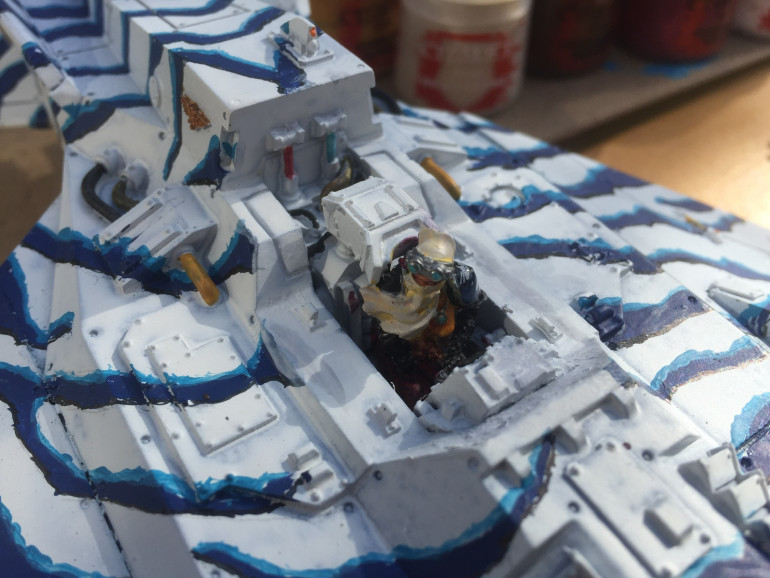 The pilot is finished (more or less). I will be leaving the glass on the cockpit clear so that you can actually see the pilot. I’ve also taken the opportunity to add two transfers to the left shoulder pad - an Aquila and a white spade which come from the Cadian infantry transfer sheet.
The pilot is finished (more or less). I will be leaving the glass on the cockpit clear so that you can actually see the pilot. I’ve also taken the opportunity to add two transfers to the left shoulder pad - an Aquila and a white spade which come from the Cadian infantry transfer sheet.The cockpit frames and rear panels were painted with two coats or Abaddon Black and a steady hand! Rivets and hinges were painted with Retributor Armour and washed with Reikland Fleshshade.
Transfers from the Cadian infantry and Imperial Guard tank transfer sheets were added and protected with a coat of ‘ardcoat followed by Stormshield to reduce the gloss shine.
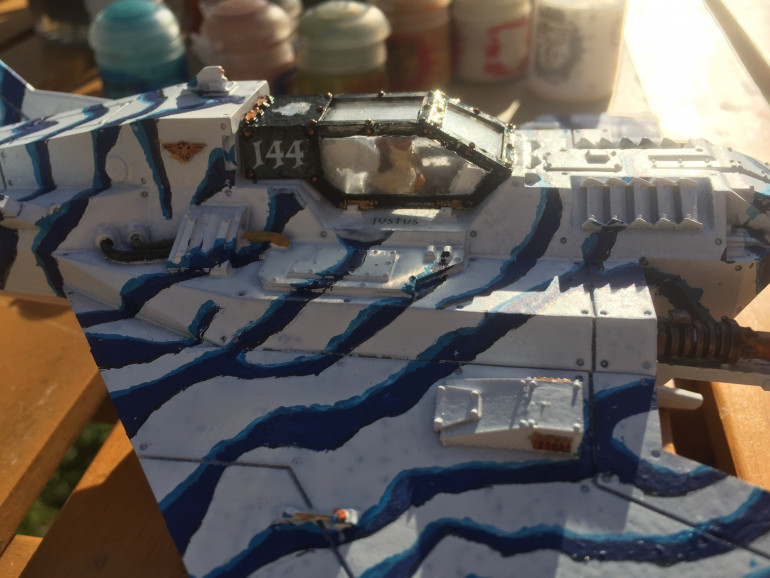 Voss Pattern Lightning Strike Fighter designation No. 144 - The Blue Max. Note the cockpit has not been glued down yet as I may still want to tinker with the pilot and insides.
Voss Pattern Lightning Strike Fighter designation No. 144 - The Blue Max. Note the cockpit has not been glued down yet as I may still want to tinker with the pilot and insides.Next up will be the Thunderbolt. I’m leaving the weathering and bases until I have both craft built and can be consistent with the base design and weathering colours to tie the models together.
Time taken:
Pilot painting – 1 Hour
Cockpit painting – 30 mins
Transfers – 30 mins
Thunderbolt - What’s in the box?
Actually it’s what’s in the bag! In typical fashion, another hiatus after the Voss Pattern Lightning meant I needed a bit more inspiration to kickstart back into the project. Hey presto if you need inspiration just look at what @FCostin (New BOW/OTT recruit Free) has painted for her first model. ???
And this has given me that added (and vital) impetus to keep going and keep improving. ? This community simply continues to inspire… especially during these pandemic times. ?
So, anyhow, the Thunderbolt appears to be a more complex Forge World kit than the Voss Pattern Lightning. I suspect this is because it is of an older design, but like the Voss, the individual pieces look robust and well detailed with little warping.
The instructions are rather rudimentary and will require a bit of intuitive building and this is perhaps something that FW could improve on to bring up to the quality of the very useful guide on how to model with resin cast components.
 All parts appear present and accounted for and include a couple of options regarding the pilot and a clear piece of thin plastic to craft into windows for the cockpit canopy.
All parts appear present and accounted for and include a couple of options regarding the pilot and a clear piece of thin plastic to craft into windows for the cockpit canopy.After checking the components, the next step (as with the Voss Pattern Lightning and other resin kits from FW) is to carefully wash the bits in soapy water to remove the mould greasing agent. I used standard high street washing up liquid (couple of decent squirts) and warm water in an old, plastic sweet tub and carefully agitated the water and left for 24 hours before drying, ready for construction.
Next up will be preparation of the components with careful removal of the excess resin tabs and flash.
Time taken:
Sorting and checking individual components – 30 Minutes.
Washing and drying components – 24 hours.
Thunderbolt - Construction
I needed to prep the Thunderbolt in a similar fashion to the Lightning with washing, drying, removal of tabs and excess flash and washing again and drying ready for construction.
I mentioned before that the instructions were pretty rudimentary and certainly I had to use my instinct on how the pieces actually went together. With such poor instructions, I tested each piece in its location before gluing – this time with Loctite Super Glue Gel 3G. I actually used two lots of glue and at £3 each the only advantage over the Citadel gel tubes was the control mechanism and so it was a tad disappointing to go through more glue than I had foreseen.
There are also a couple of bits that I simply can’t tell where they should go from the instructions so I will have to Google some images of built Thunderbolts to see if I can spot their location.
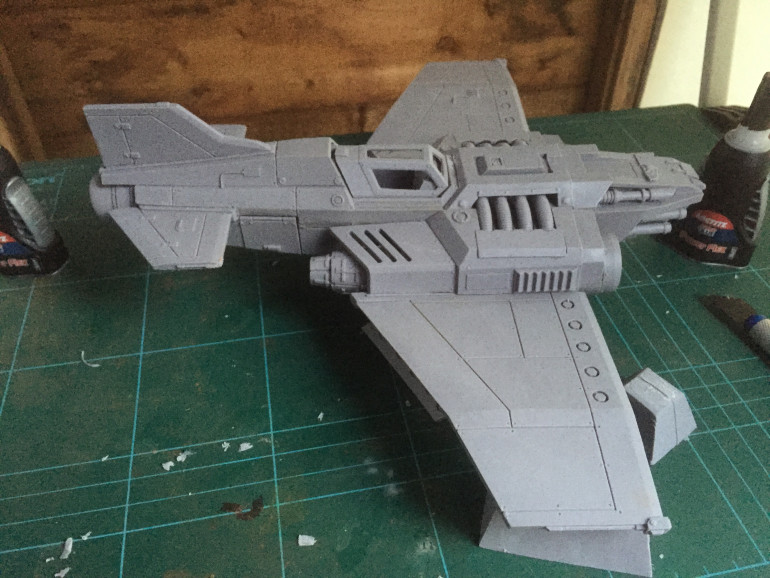 Thunderbolt fully constructed bar a couple of odd bits. Note that the cockpit is glued in place, but the canopy is not yet as I need to create a unique pilot and cut the clear plastic for the glass panels. The pilot’s seat has also not been inserted yet as I will need to build the pilot into the seat before gluing it into the cockpit.
Thunderbolt fully constructed bar a couple of odd bits. Note that the cockpit is glued in place, but the canopy is not yet as I need to create a unique pilot and cut the clear plastic for the glass panels. The pilot’s seat has also not been inserted yet as I will need to build the pilot into the seat before gluing it into the cockpit. 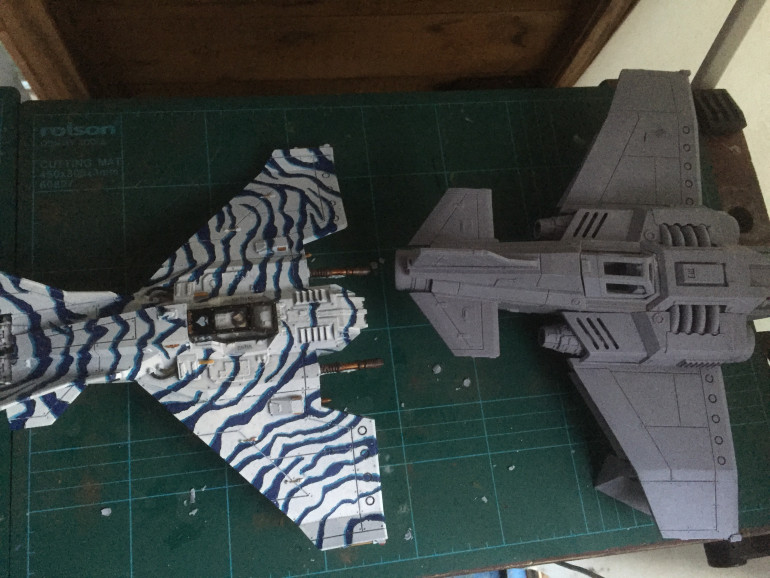 Here is a size comparison of the Thunderbolt against the Lightning. You can see how the Thunderbolt gets labelled as a heavy fighter. As with the Lightning I will need to use some liquid green stuff to smooth into some gaps in the joins.
Here is a size comparison of the Thunderbolt against the Lightning. You can see how the Thunderbolt gets labelled as a heavy fighter. As with the Lightning I will need to use some liquid green stuff to smooth into some gaps in the joins.Next up I need to use liquid green stuff on a few gaps on the Thunderbolt fuselage and roll out some green stuff putty as I kit bash a pilot to represent ‘The Red Baroness’.
Time taken:
Preparation if components: 3 hours
Construction: 3 hours
Thunderbolt - Kit-bashing ‘The Red Baroness’ Pilot
Having successfully stuck the Thunderbolt together, I needed to use some Citadel Liquid Green Stuff to smooth over a couple of gaps in the fuselage. Although when inspecting the components when cleaning, there was no obvious warping, it really is only when you actually construct the model that these small gaps may appear… so investing in decent liquid green stuff does prove worthwhile in hiding these defects.
Whilst the green stuff was left to dry, I moved on to creating the pilot. I knew I didn’t want to use the existing pilot and indeed when you compare the size of the pilot of the Thunderbolt to the Lightning, he does look tad smaller. I’ve an idea I may use him in a piece of scenery.
So, what would I use as the pilot and build into the free, empty seat. Well, I originally had said I’d use another Necromunda mini from Forge World, but I also came across a number of broken metal Escher minis in my bits box and considered how I could cannibalise them to make the pilot. Then a bolt of inspiration hit me… This is going to be the ‘Red Baroness’ so really I didn’t want a run of the mill Escher trooper, I needed a mini which said ‘royalty’. Enter stage left… a Citadel Finecast Vampire Counts Von Carsten hero to save the day!
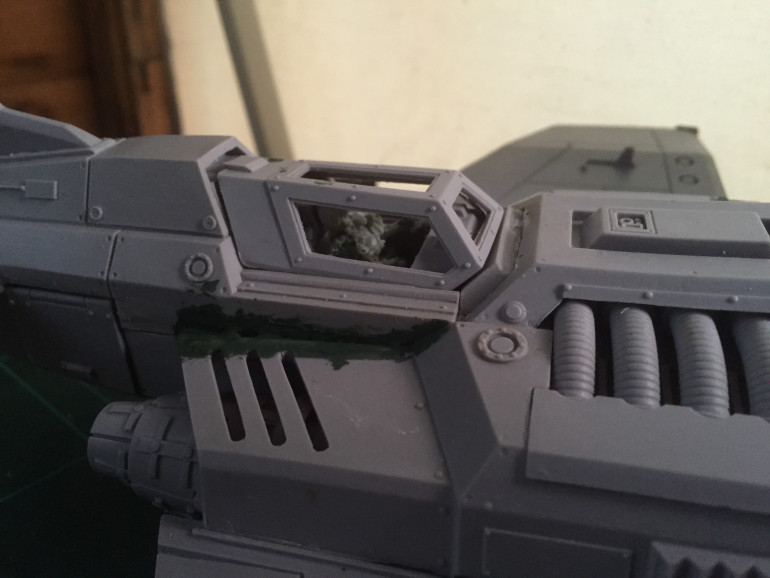 Thunderbolt Pilot installed. The cockpit canopy remains detached as I next prepare for the painting. The Red Baroness needed new green stuff putty legs created and repositioning of the arms to suggest managing the Thunderbolt controls. I think she looks suitably ‘royal’ to represent ‘The Red Baroness’?
Thunderbolt Pilot installed. The cockpit canopy remains detached as I next prepare for the painting. The Red Baroness needed new green stuff putty legs created and repositioning of the arms to suggest managing the Thunderbolt controls. I think she looks suitably ‘royal’ to represent ‘The Red Baroness’?Next up is undercoating and then painting the The Red Baroness…
Time Taken:
Liquid Green Stuff gap filling: 30 mins
Sorting and planning Pilot: 30 mins
Construction of Pilot, Green Stuff sculpting replacement legs and installation: 45 mins
Thunderbolt - The Paint Job!
It’s been a couple of weeks since my last entry, mainly because I’ve just be in the flow of cracking on with the painting of the Thunderbolt without thinking about the blog. You know how it it – when you are in the zone, you just want it to never end!
So, to update the blog now, I began by undercoating the Thunderbolt with Plastikote white spray paint and once dry used Matt Red spray for the upper fuselage and wings.
I decided that I wanted the Thunderbolt to have a unique camouflage pattern and immediately thought of the Red Admiral butterfly, but actually it’s more black than red and what I had for decades was the Red Admiral was in fact a Peacock butterfly. A photo I’d taken in the garden inspired the pattern and so the painting of details began.
To start with I used Carroburg Crimson wash to blend into the recesses. I then used Abaddon Black to add a dark layer to the wing edges and then Wraithbone to create the Peacock butterfly eyes on the wings and tail fins. I used Lothern Blue, Averland Sunset and Mephiston Red to create further colouring and blending of the Peacock camouflage. I also painted the metalwork using Retributor Armour and Chainmail with a wash of Reikland Fleshshade.
Next up was to create unique transfers for the Thunderbolt which could also be used on the Lightning and tie the two to the Dragon Wing/Squadron. I selected an image from page 27 of the 1996 edition of the Warhammer Armies Bretonnian supplement, photographed it and turned the image into a series of small and large transfers along with sets of designation numbers and pilots’ name boards. The transfer sheet, once printed, was sprayed with Purity Seal and coated with ‘ardcoat for durability and then individual transfers were carefully cut out, soaked in water and applied to both the Thunderbolt and Lightning.
Where transfers overlapped grooves in the fuselage panels, I carefully cut the transfer using a pointed sculpting tool and applied Nuln Oil to run into the grooves. transfers were sealed with a coat of ‘ardcoat and then a coat of Stormshield to dull the gloss sheen.
I used Typhoid Technical paint and further washes to blend and begin the weathering process, culminating in Vallejo Weathering Powders (medium rust and Ochre.)
Voss Pattern Lightning - Transfers and Weathering
Turning back to the Voss Pattern Lightning, I now had the home made transfers to apply and weathering using Nuln Oil, Reikland Fleshshade and Typhoid Technical washes along with the Vallejo powders.
Time taken:
Transfers: 1 Hour
Weathering: 1 Hour
Next up – creating the flying bases…
Flying bases - a jungle themed adventure
Now that the two craft are more or less there, I needed to create solid bases. I wanted the Lightning and the Thunderbolt to both be in flight and as I have yet to do a jungle-themed base for any vehicles yet, I could imagine them flying above the tree tops. The standard flying bases did look and feel insubstantial for both craft and I can see now why you don’t see loads of pictures of the heavier Thunderbolt in flight.
I acquired some 3D printed tree kits eBay for a very reasonable price. Had some slight trepidation as they were coming from France and I wasn’t sure what effect the Brexit paperwork may have for importing such goods! It appears that the VAT gets calculated into eBay purchases now. I don’t normally promote eBay sellers, largely because I don’t agree with inflation of prices for classic minis by some sellers, but I am going to recommend rabiotsman as they sent me two additional jungle trees beyond what I ordered and they are brilliant quality.
The gallery below shows the WIP from unboxing the parts, removing the flashing, construction, plastered basing, painting with neutral, earthy browns and greens and blues for water effects, washes and flocking. The clear flying support was super glued into place to provide the required height for the craft. I used foliage washed with Biel Tan green from a 1970s Britain’s Zoo to soften and obscure the flying support.
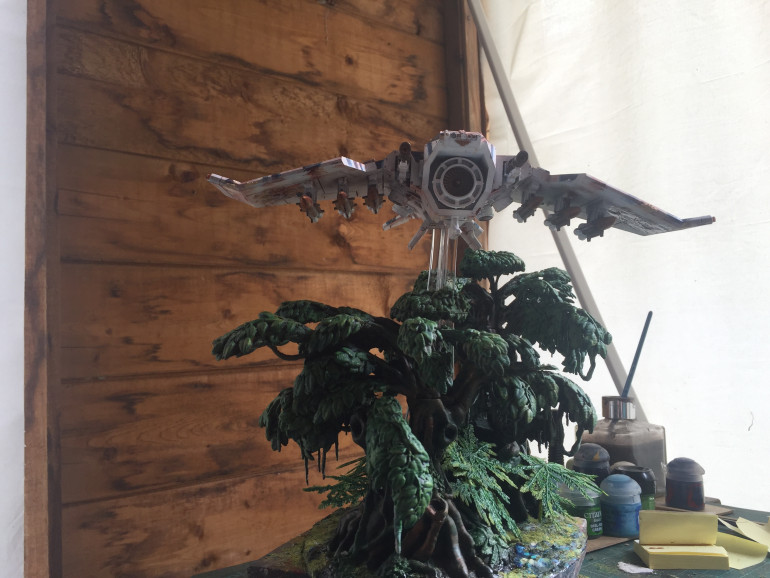 The Lightning Pattern Strike Fighter mounted onto its much more secure and solid base. It could be used as both a display piece and a playing unit. The Lightning has had additional transfers added to the underside of the wings and further weathering using Nuln Oil wash and Vallejo weathering powders.
The Lightning Pattern Strike Fighter mounted onto its much more secure and solid base. It could be used as both a display piece and a playing unit. The Lightning has had additional transfers added to the underside of the wings and further weathering using Nuln Oil wash and Vallejo weathering powders.Really enjoyed immersing myself into this part of the project and I’m actually quite chuffed at how it came together. I will next replicate the process for the Thunderbolt, but reconfigure the trees so that they aren’t exactly duplicated, but will fit in as part of the same jungle terrain.
Time Taken: (not including drying times)
Base preparation: 2 Hours
Tree Painting: 2 Hours
Construction of base, plastering and ground painting: 2 Hours
Flocking: 30 minutes
Transfers for underside of Lightning wings: 30 minutes
Weathering: 1 Hour
Flying Bases - The Thunderbolt roars above the treetops
It’s very useful keeping a blog of your project, because this gave me a great reference aid to constructing the second flying base so that it was both different to the first, yet still fitted in with jungle theme.
The multi-piece tree kits allowed for some reconfiguration, but only if I used Liquid Green Stuff to fill the gaps. The orientation on the cutout base allowed for that distinction from the Lightning’s base and enabled me to position the clear, upright stand in a slightly higher position so that the Thunderbolt could be above the trees and the Lightning.
Again, the gallery below shows the Thunderbolt’s base WIP from construction through to painting using the same palette as the Lightning’s base.
To identify the base as belonging to the Red Baroness, I wanted to capture a red colour on the jungle floor. Rather than simply put a red plant, I decided to use the Thunderbolt’s red paint palette to add a Wizkids Giant Scorpion. This is a really detailed one-piece hard plastic mini (£4.99) and would be embedded into the Polyfilla base and part hidden by foliage.
As with the Lightning, additional number and insignia transfers were added to the underneath of the wings and the whole craft was weathered further with Vallejo weathering powders and Nuln Oil wash.
Next up will be to check and touch-up any glaring misses and to take a series of better close up and detailed photos of both the Thunderbolt and the Lightning ready for action.
Time Taken:
Base construction and painting (not including drying time) 8 hours
Scorpion paint job: 1 hour
Transfers: 30 minutes
Weathering: 30 minutes
Thunderbolt and Lightning - Attack Formation
My amateur attempts to capture the finale of the Spring Clean Challenge 2021… it’s now technically Summer, so we will call it a day with these two but it’s sown the seeds for more jungle themed adventures…
Gallery photos taken on an iPhone SE4 (2016) with background provided by a white double sheet. Lighting provided by the mid-morning sun through the window. Shadows provided by me! Not perfect, but I hope they will do?
Time taken:
Photos – 15 minutes
Upload to BoW – 3 hours because it kept crashing!
Next up: I’ve a rebel Arvus Lighter to build, paint up and to be the object of the hunt for our intrepid pilots.
































